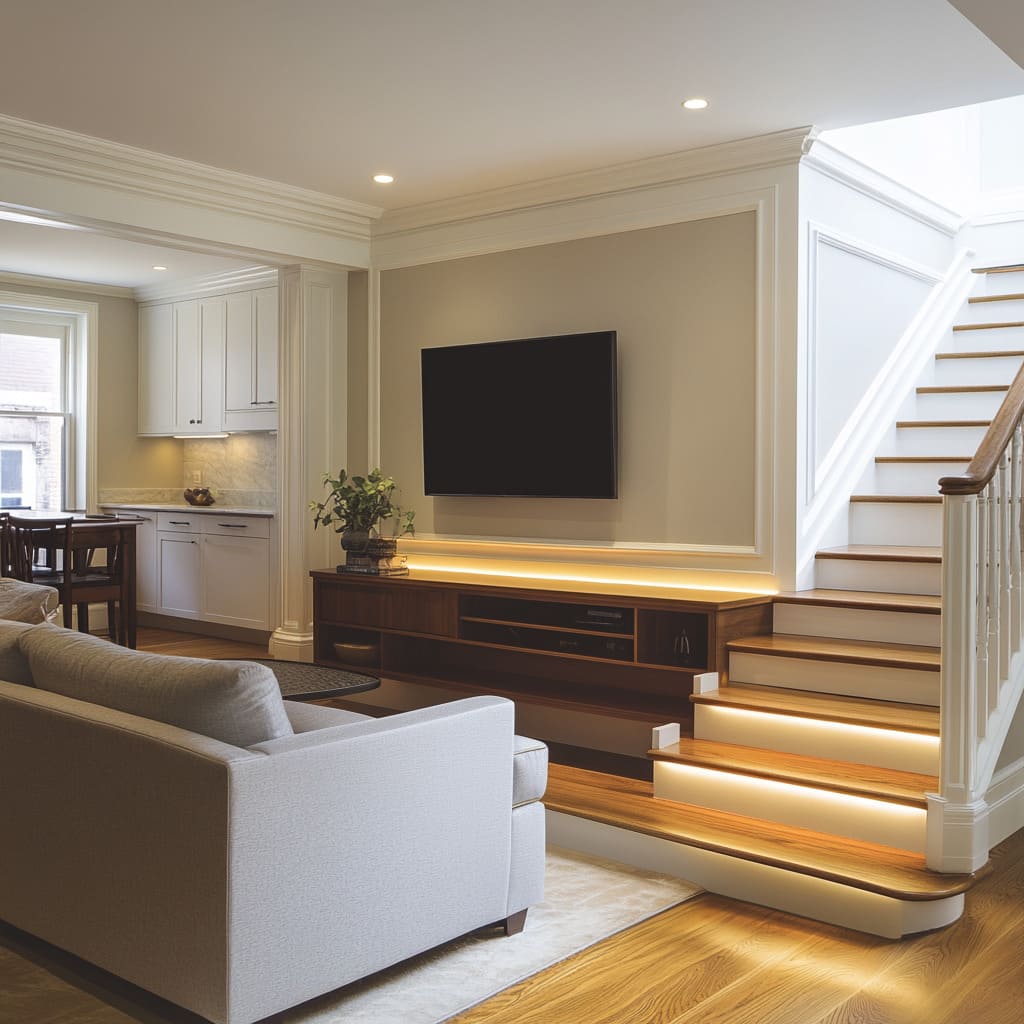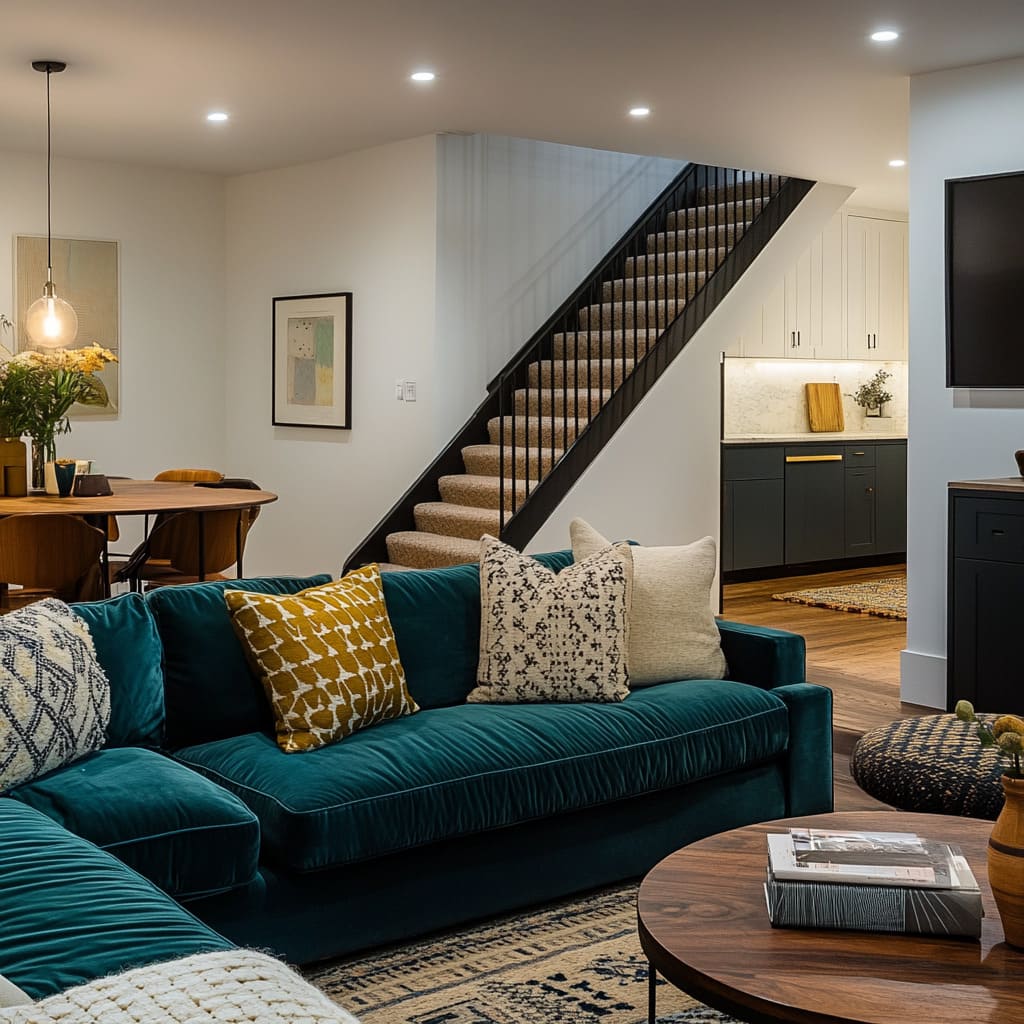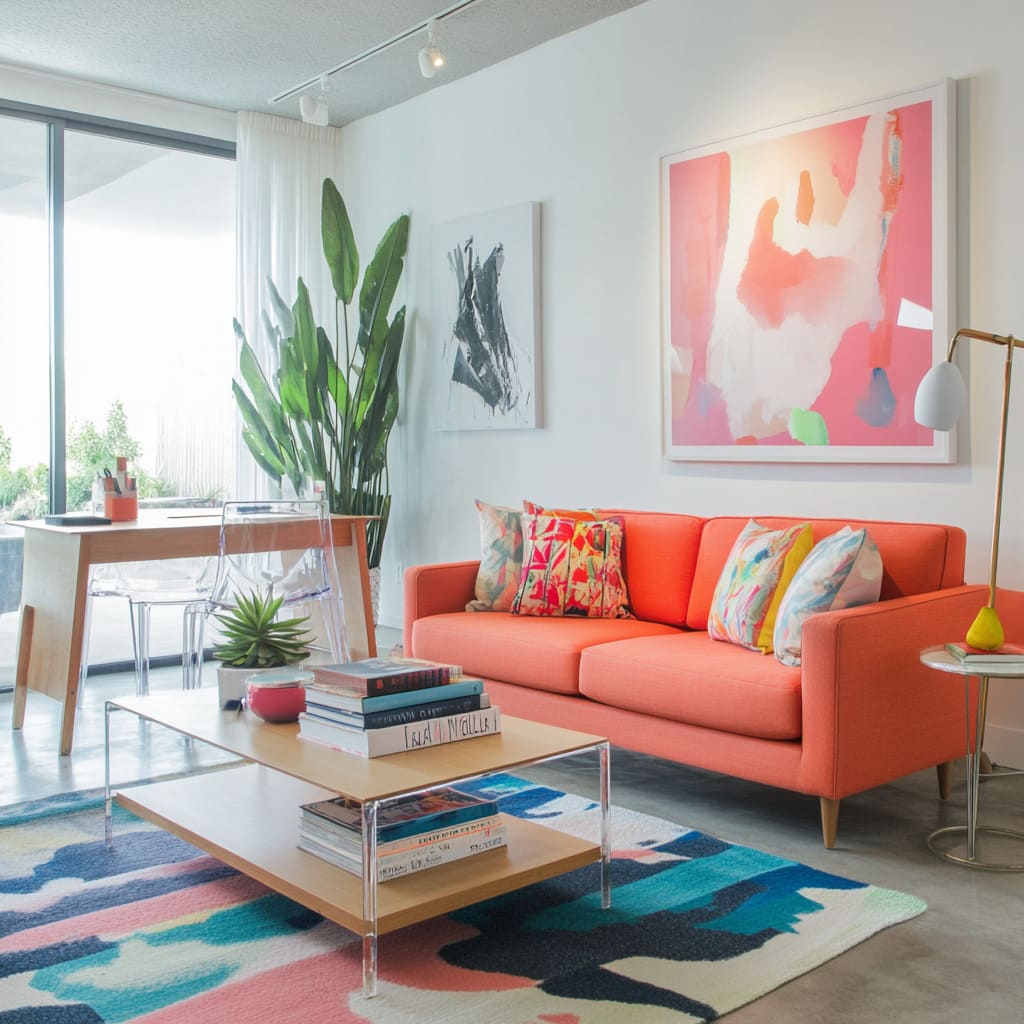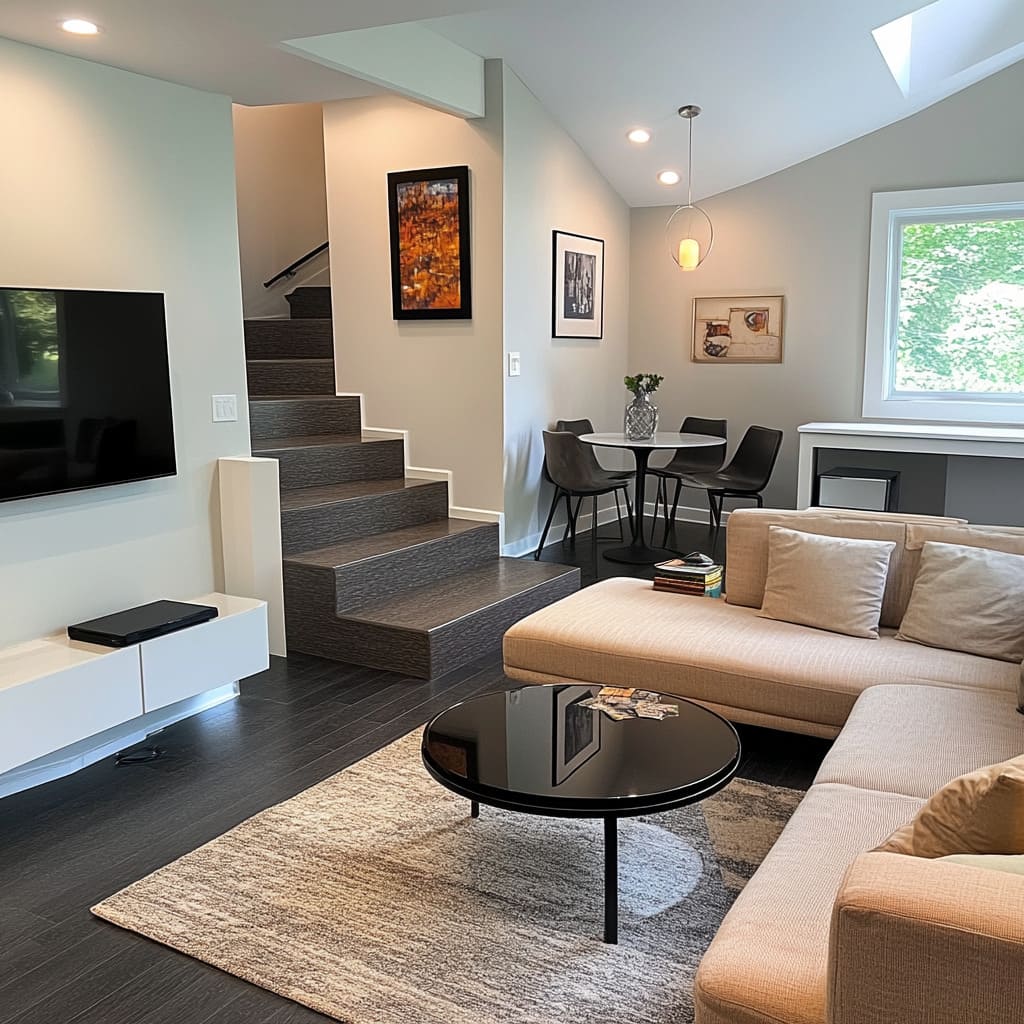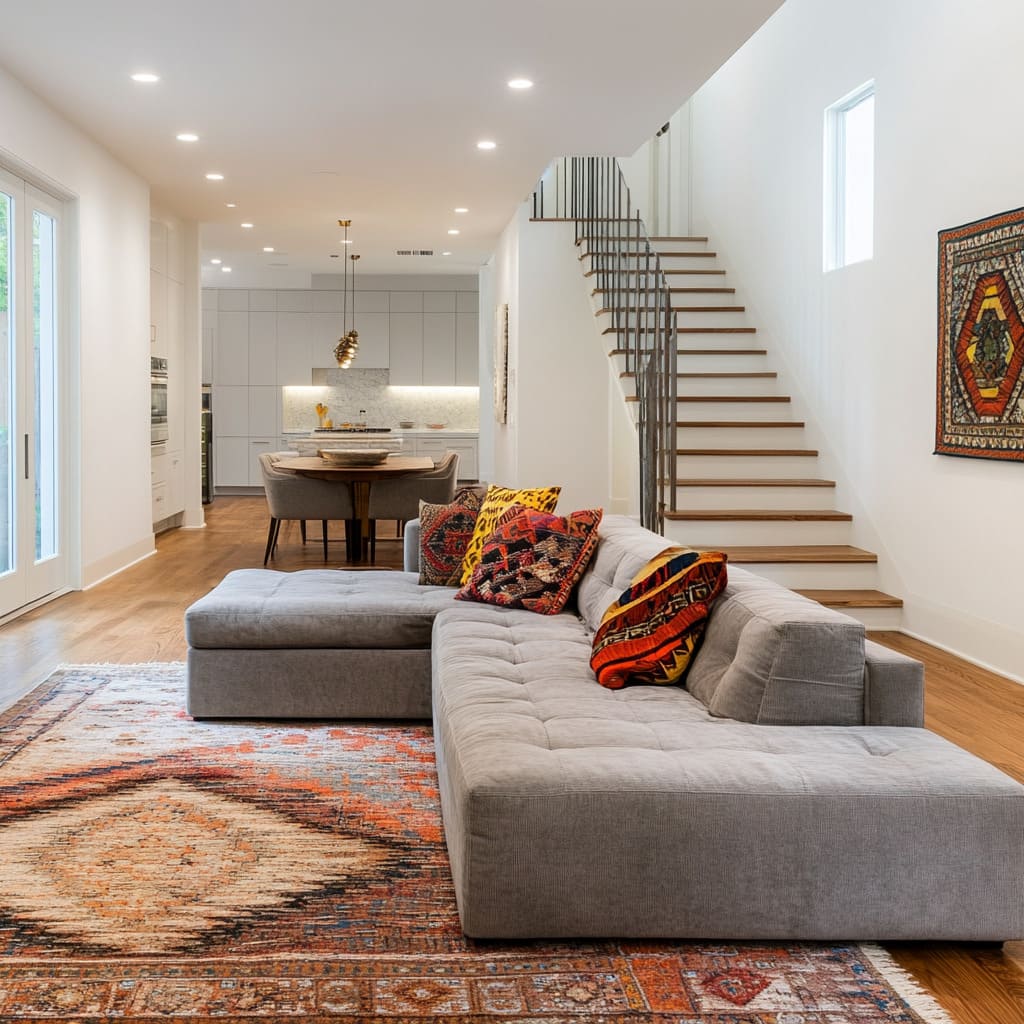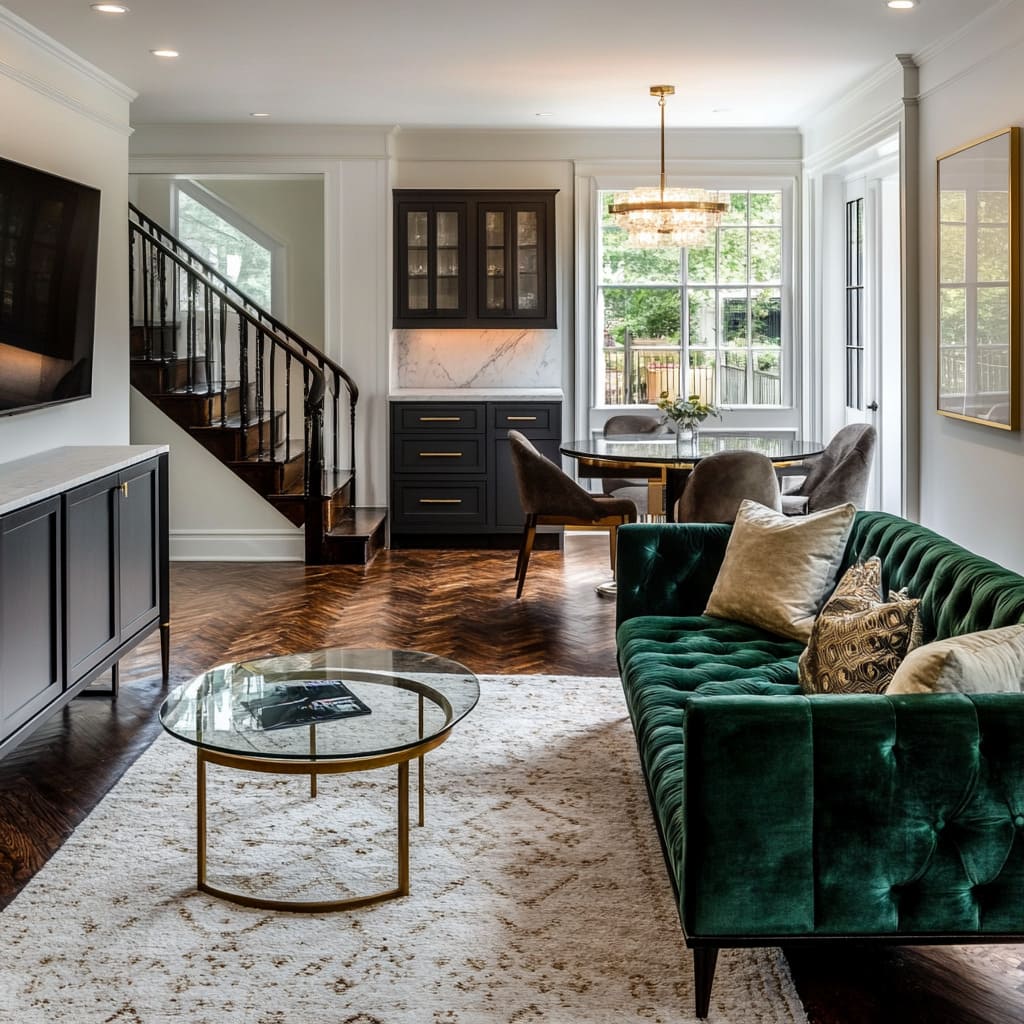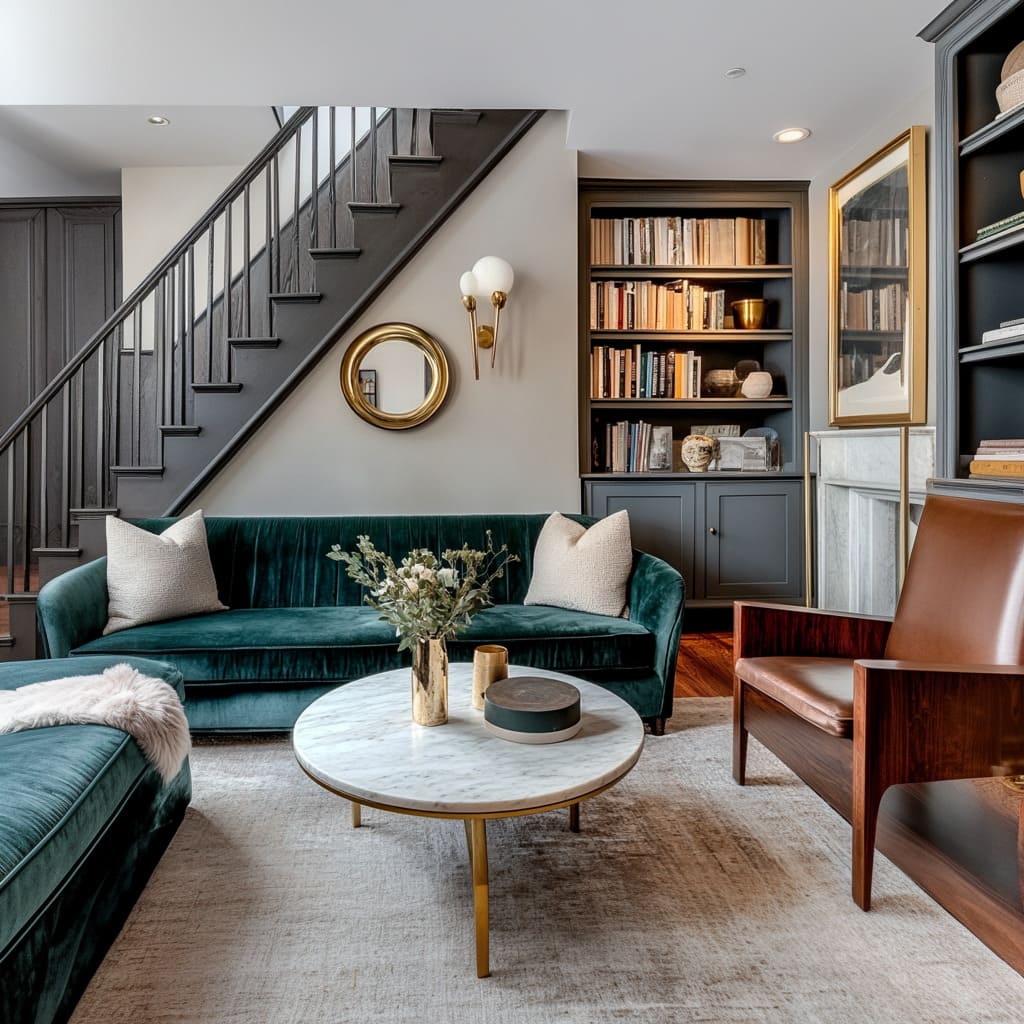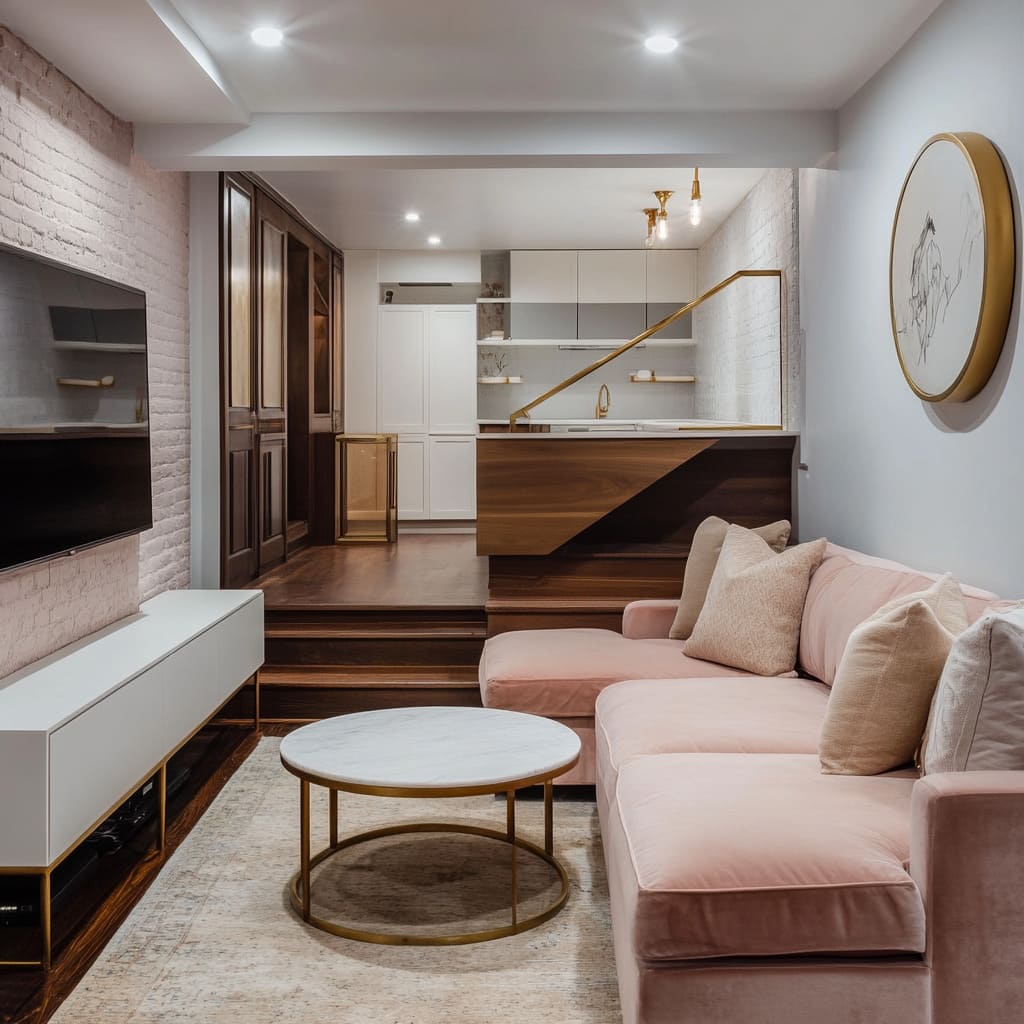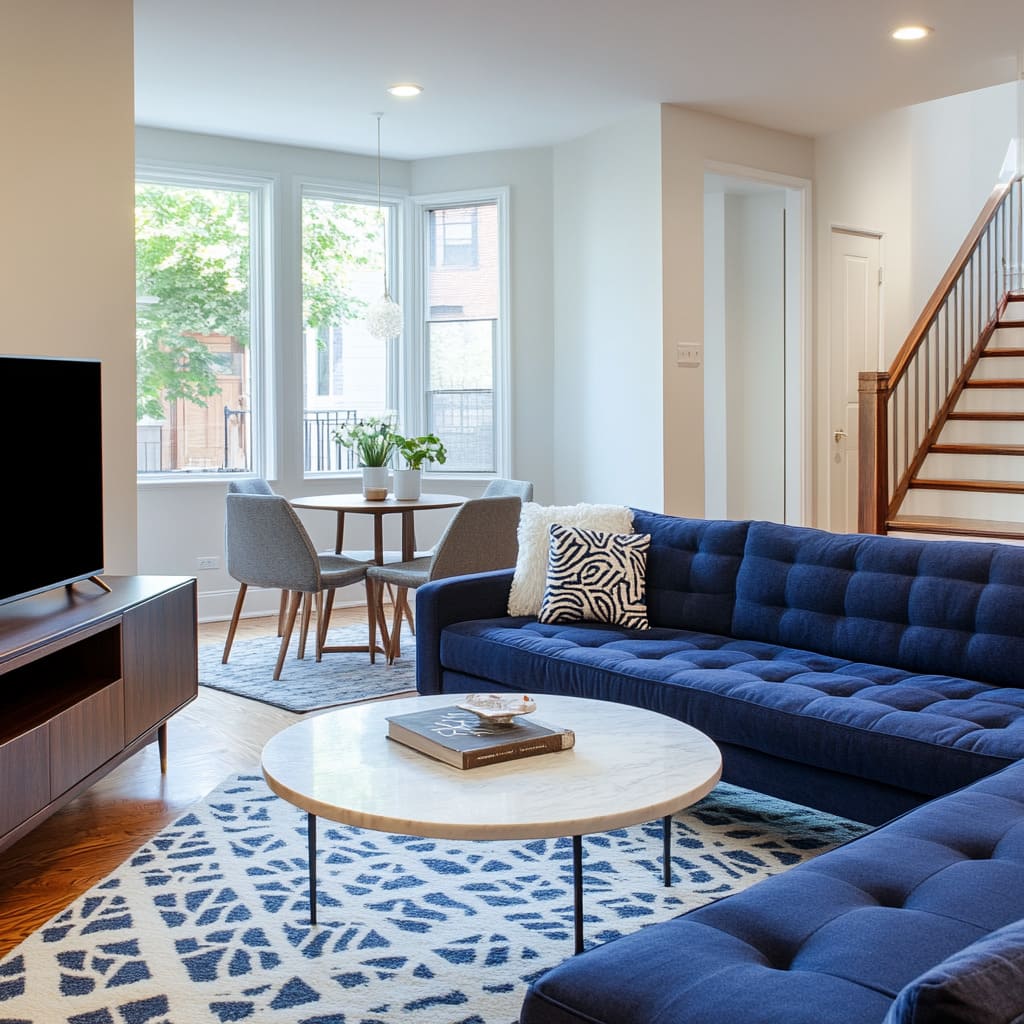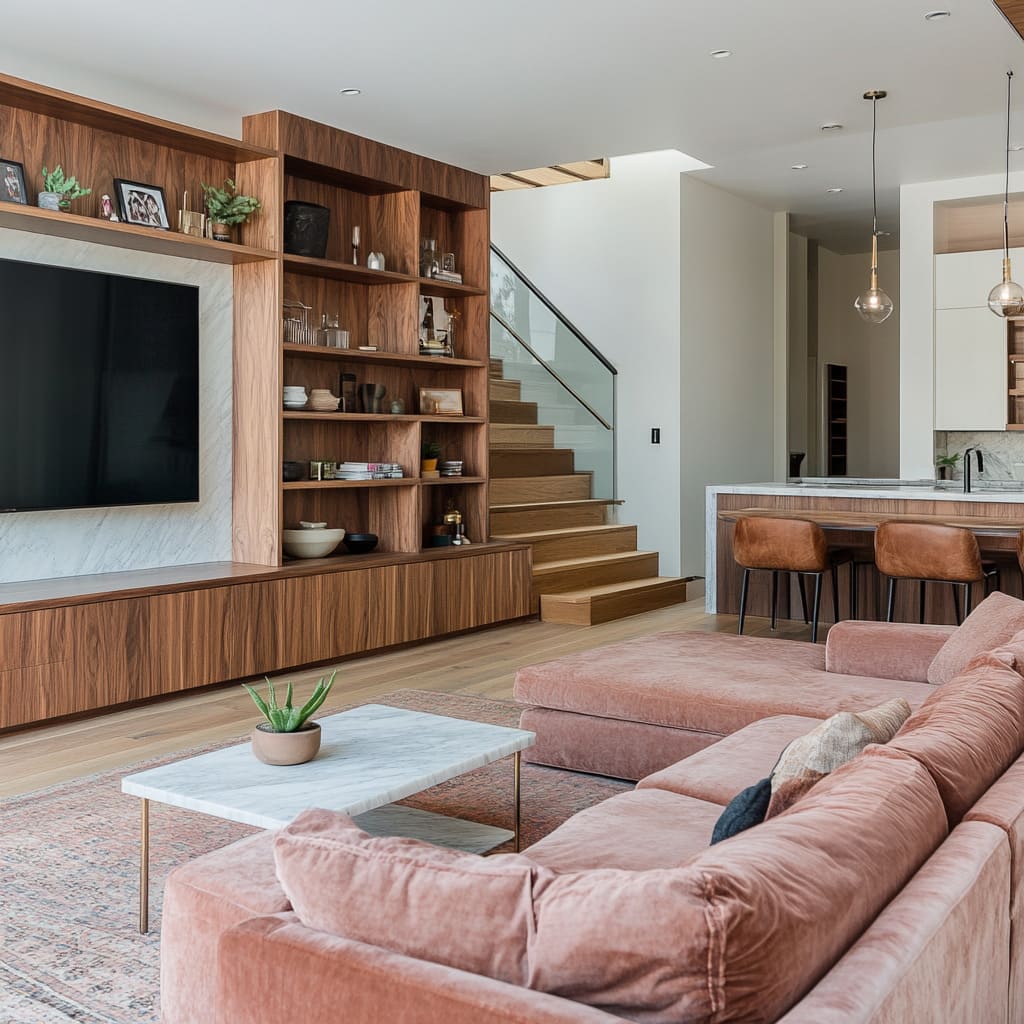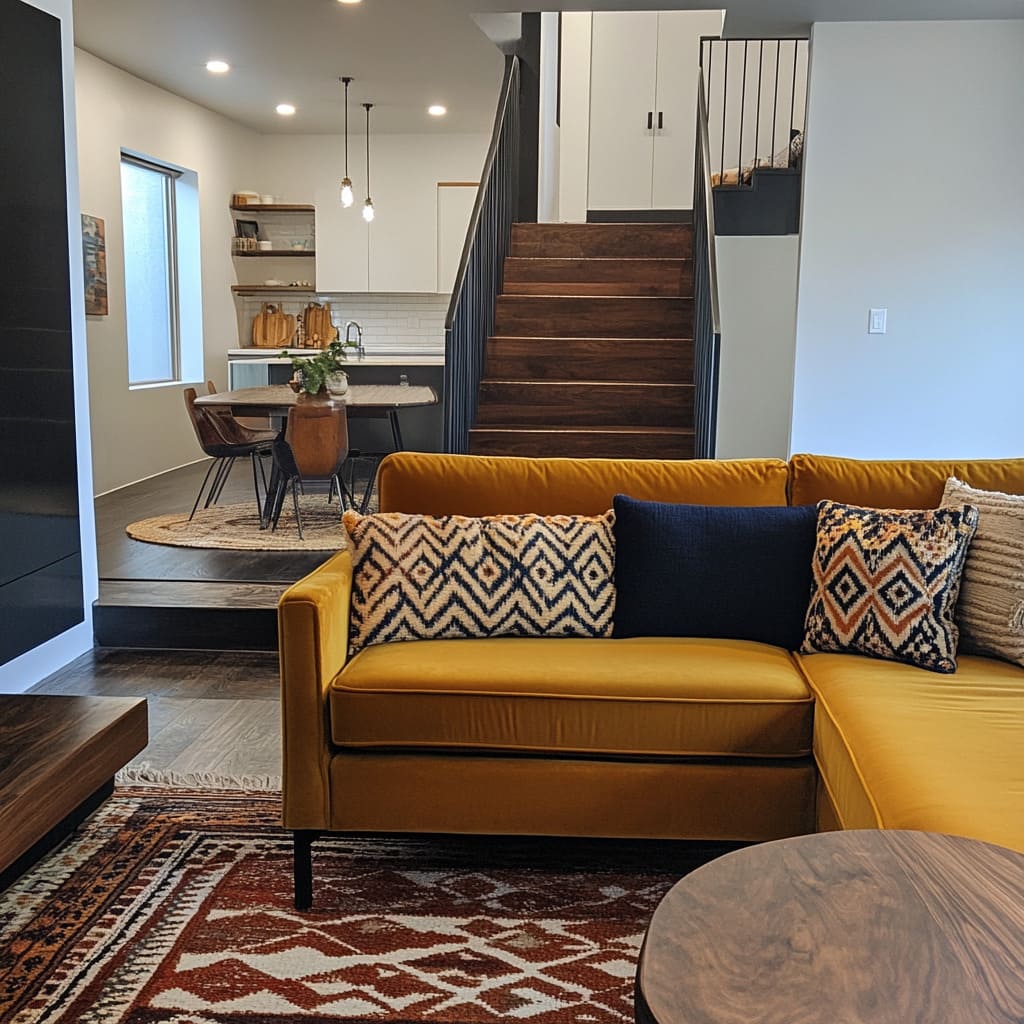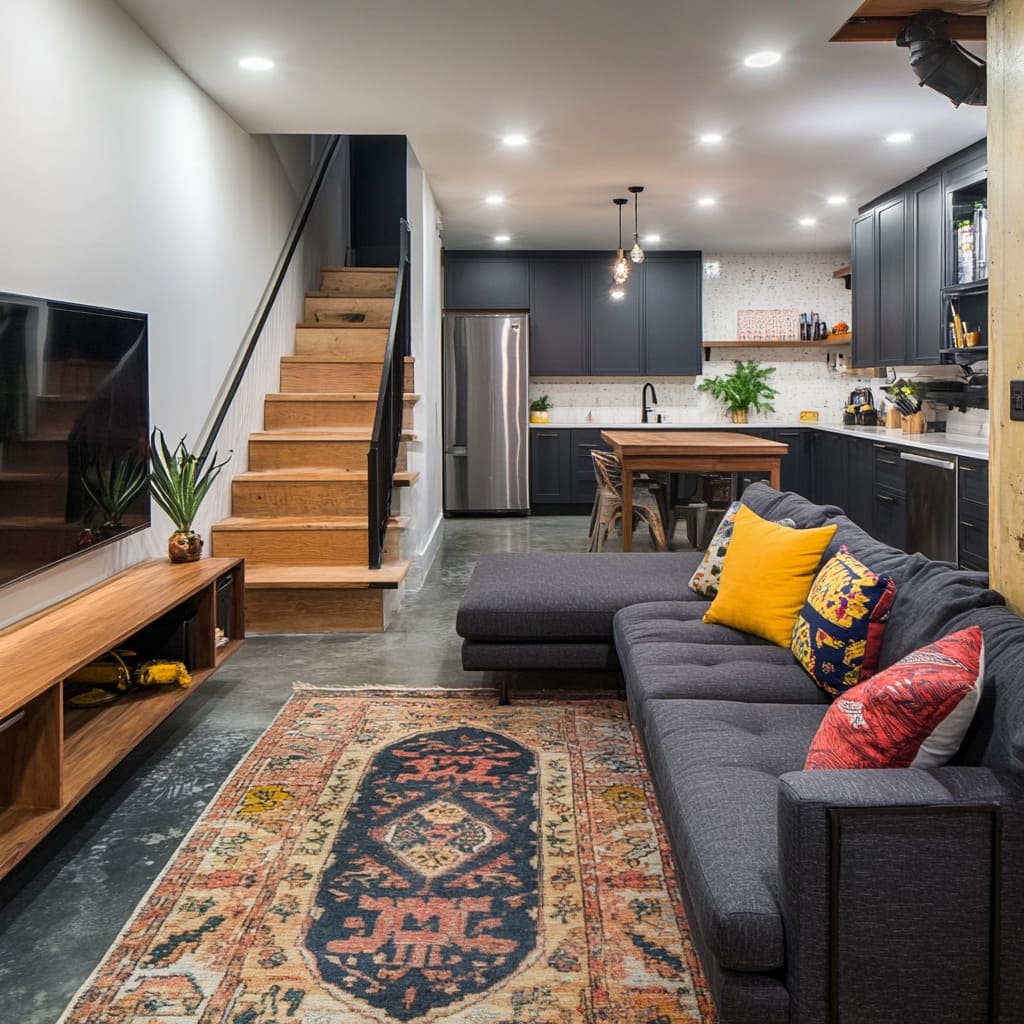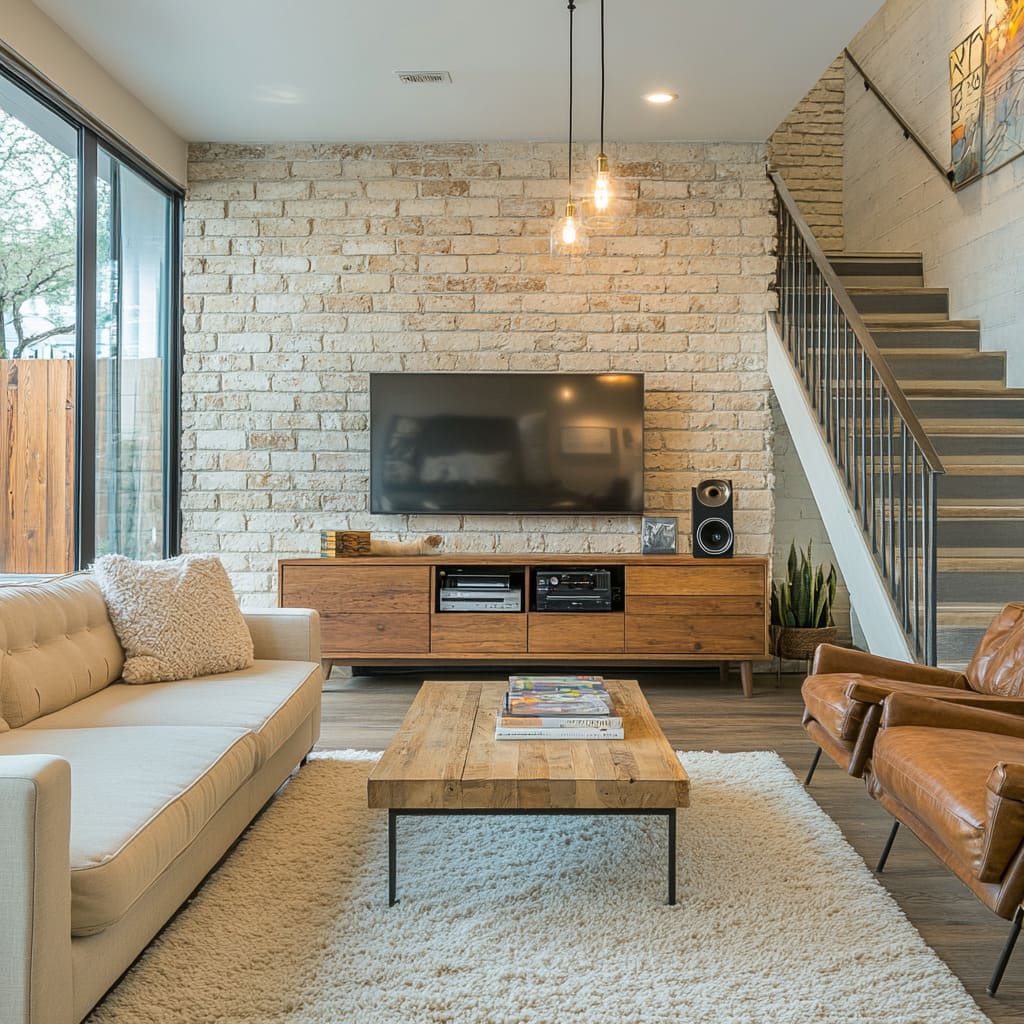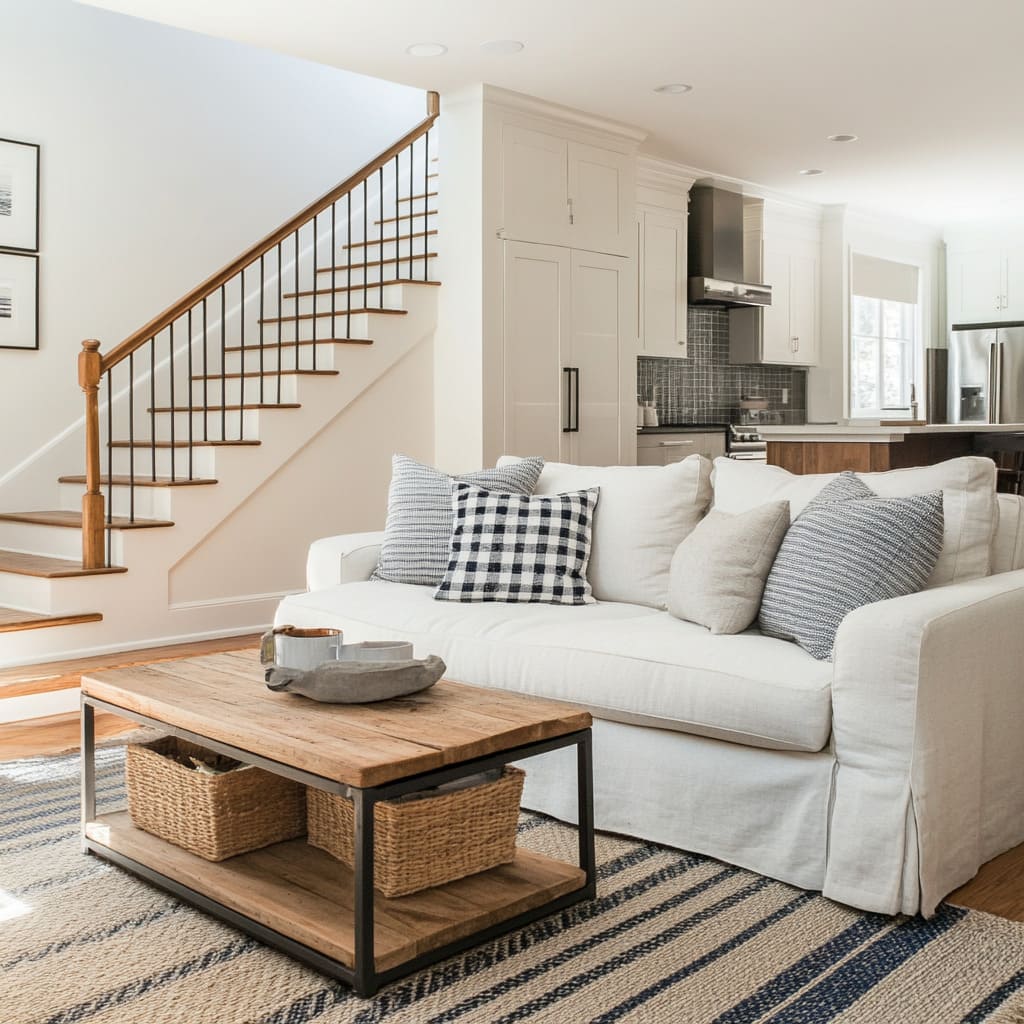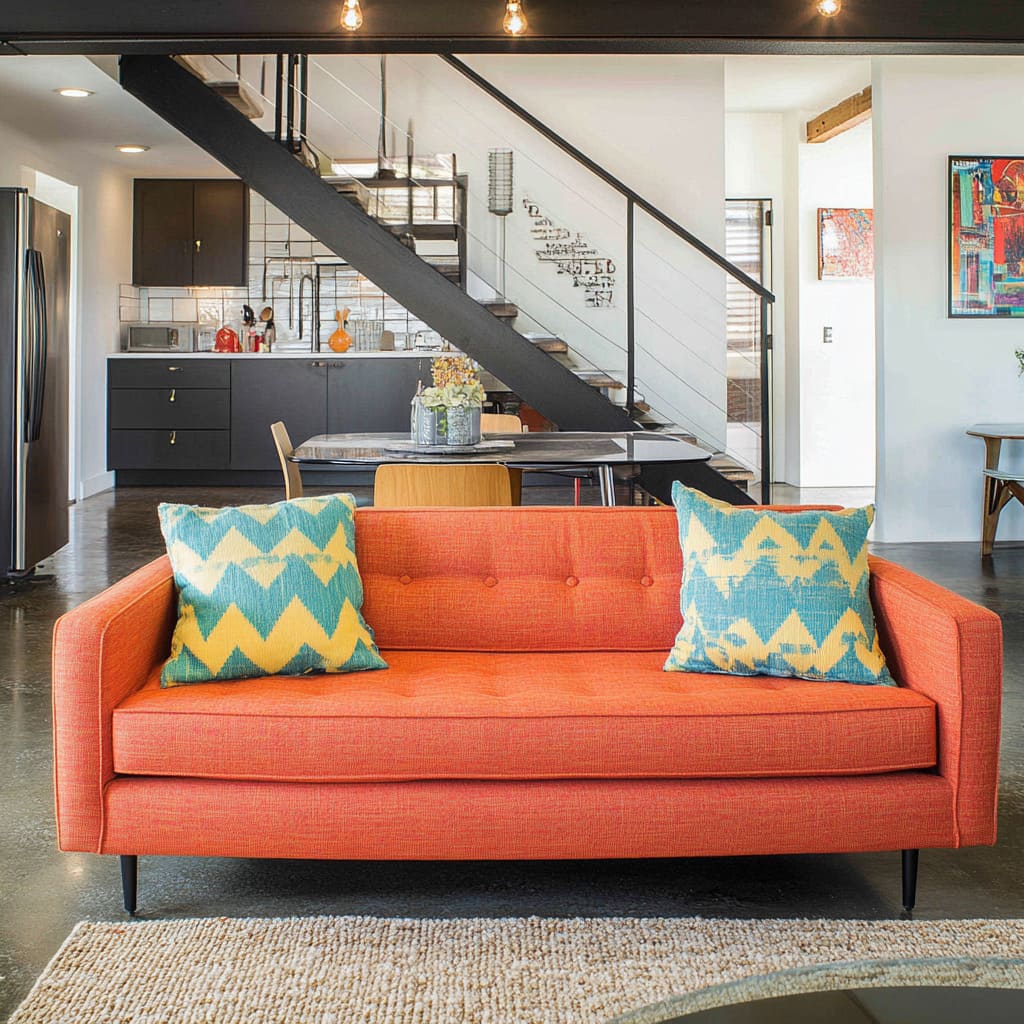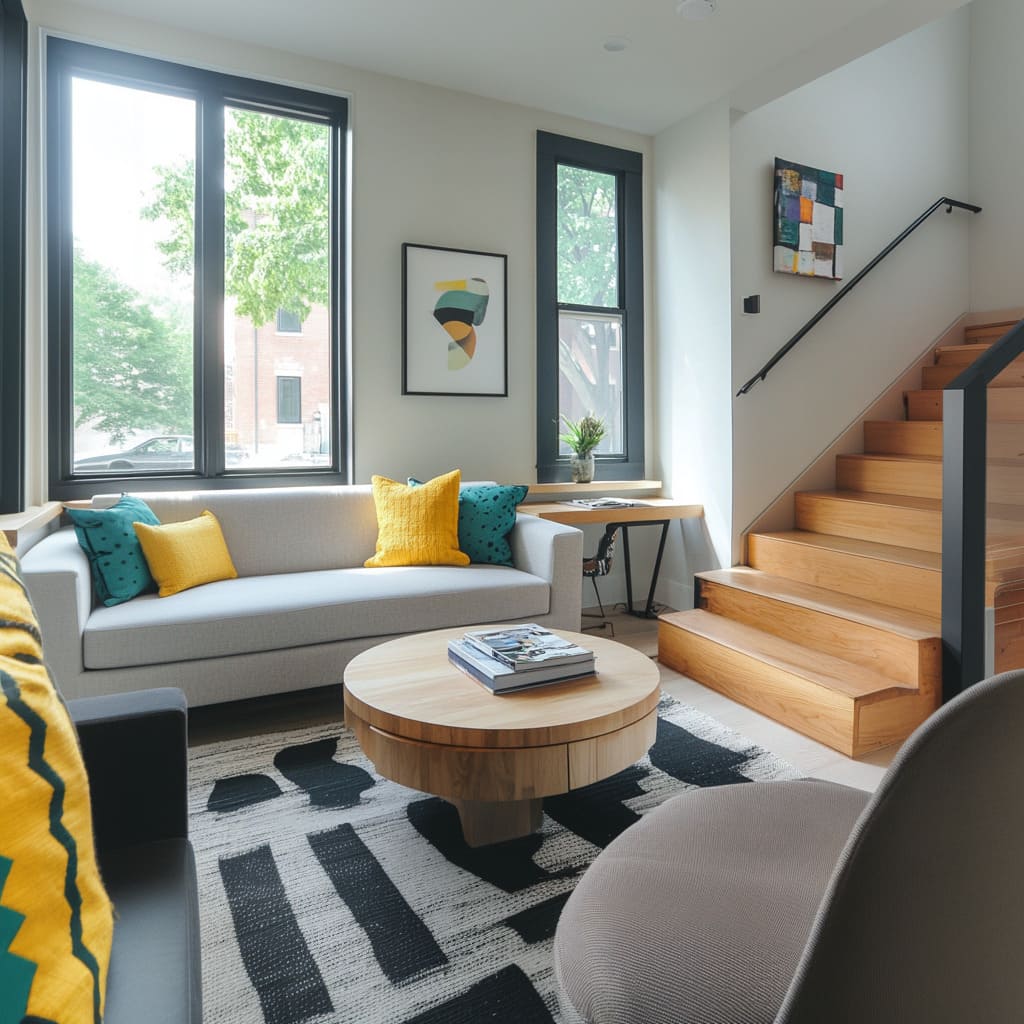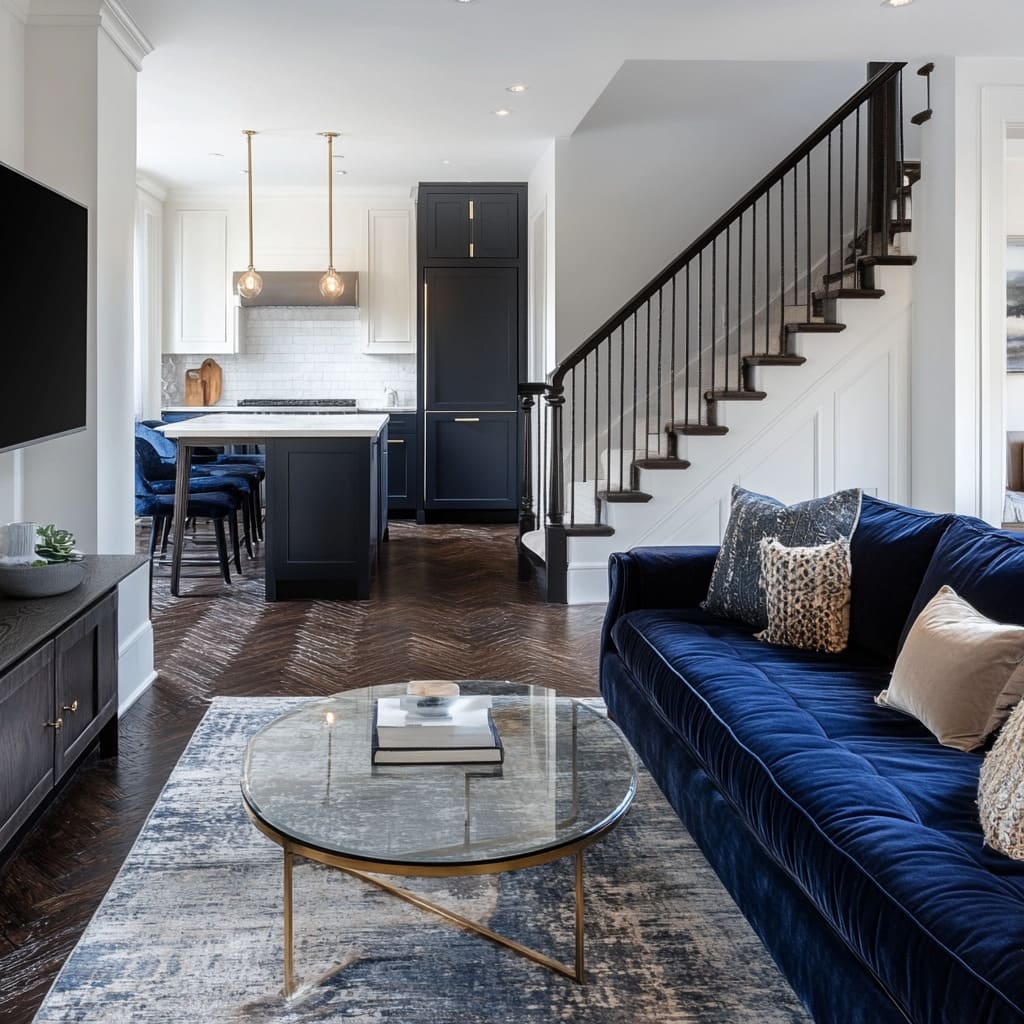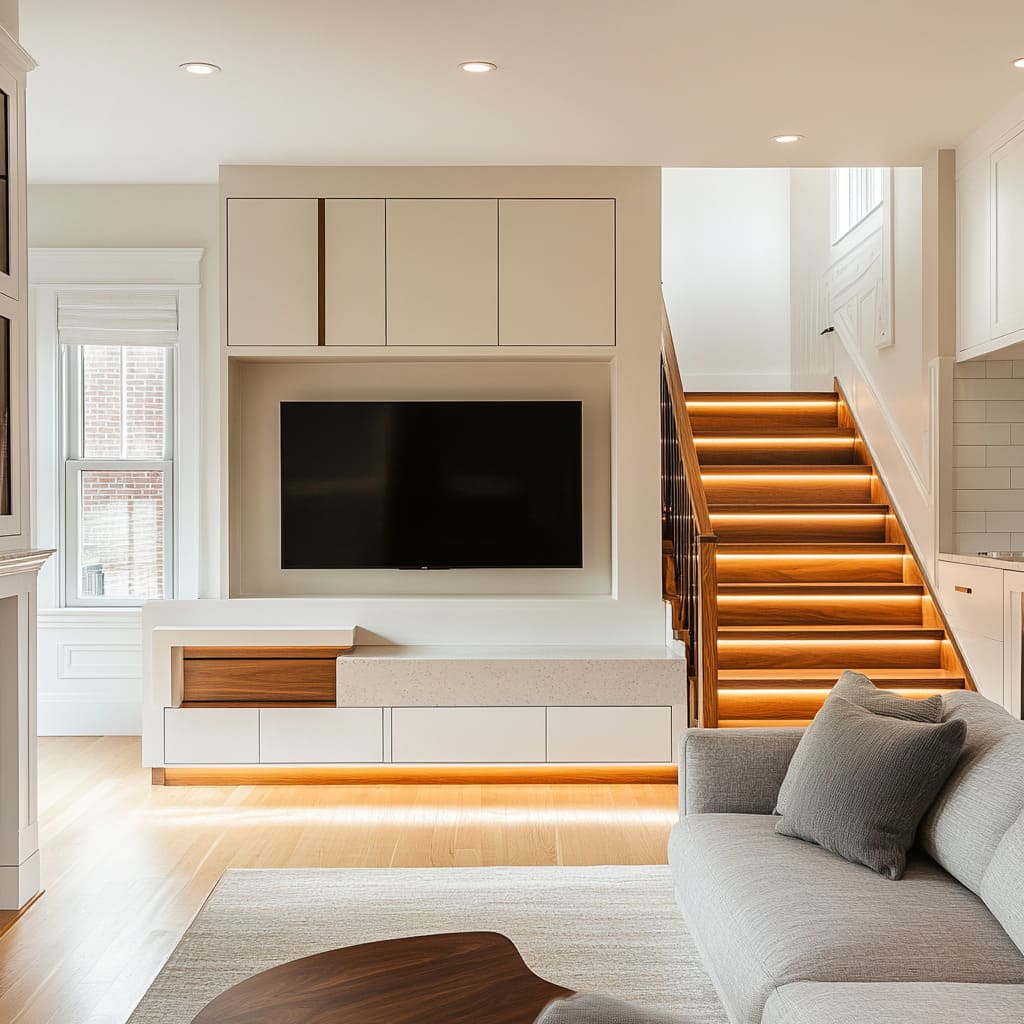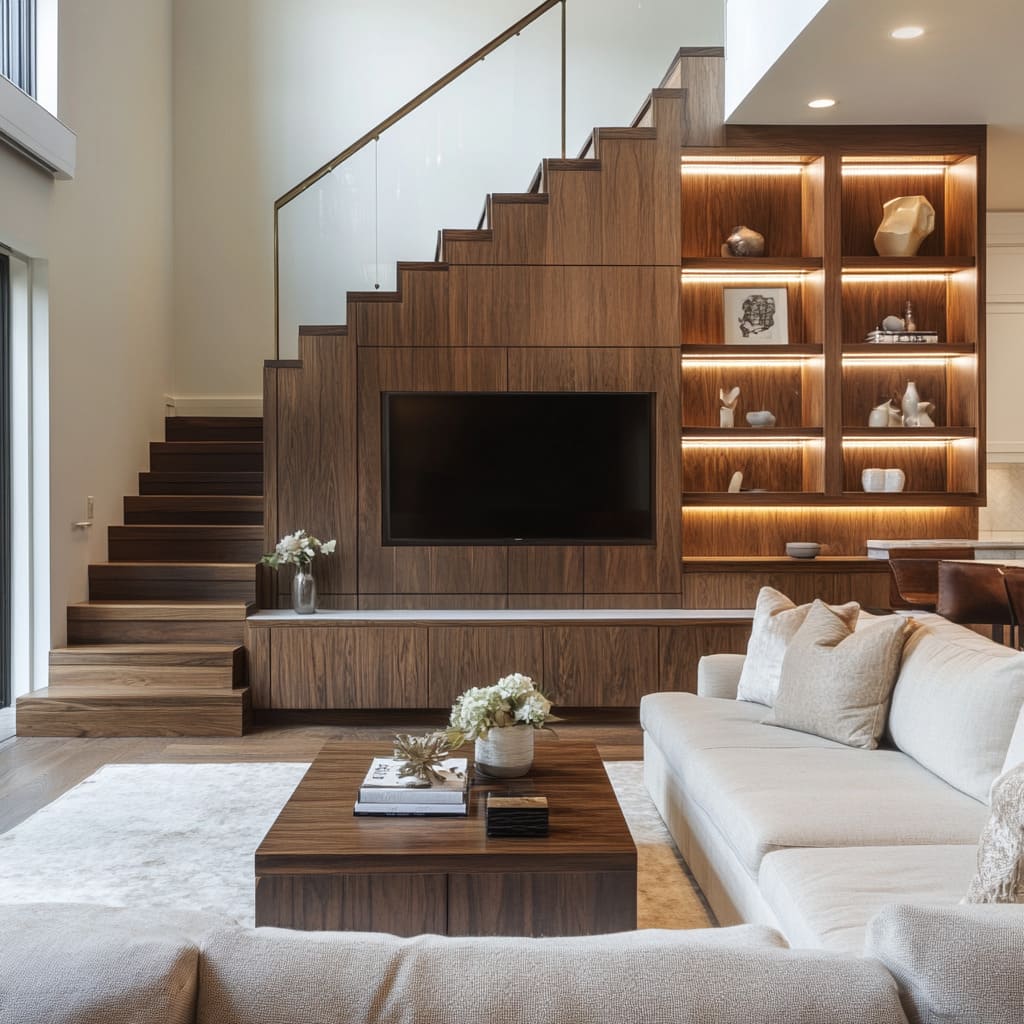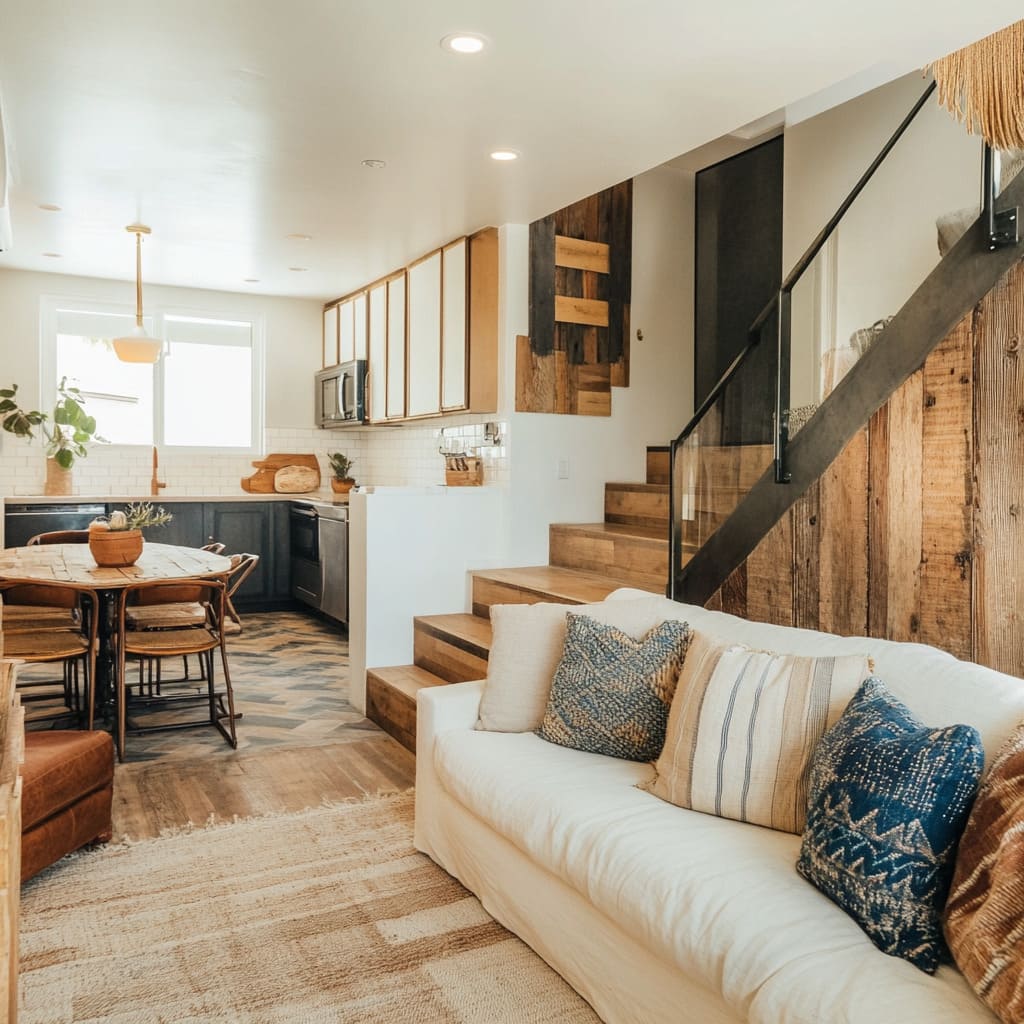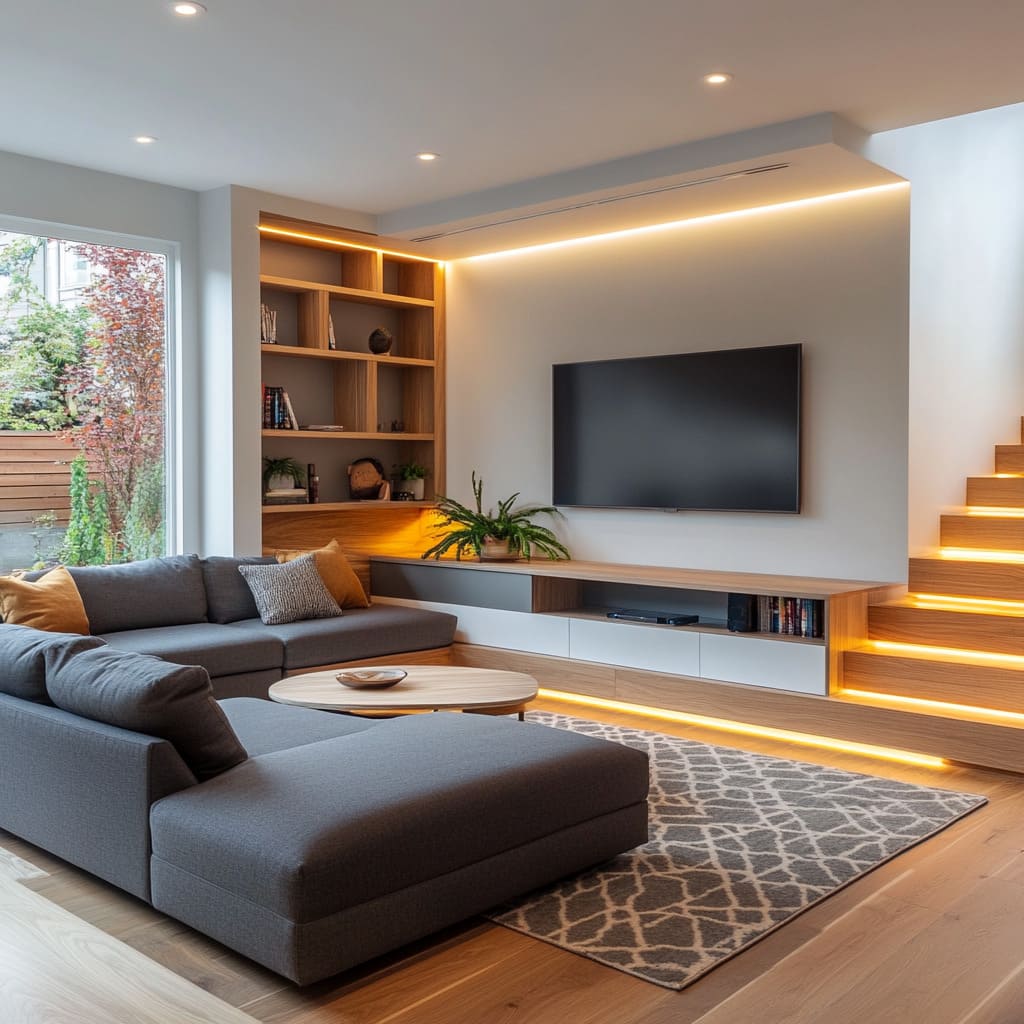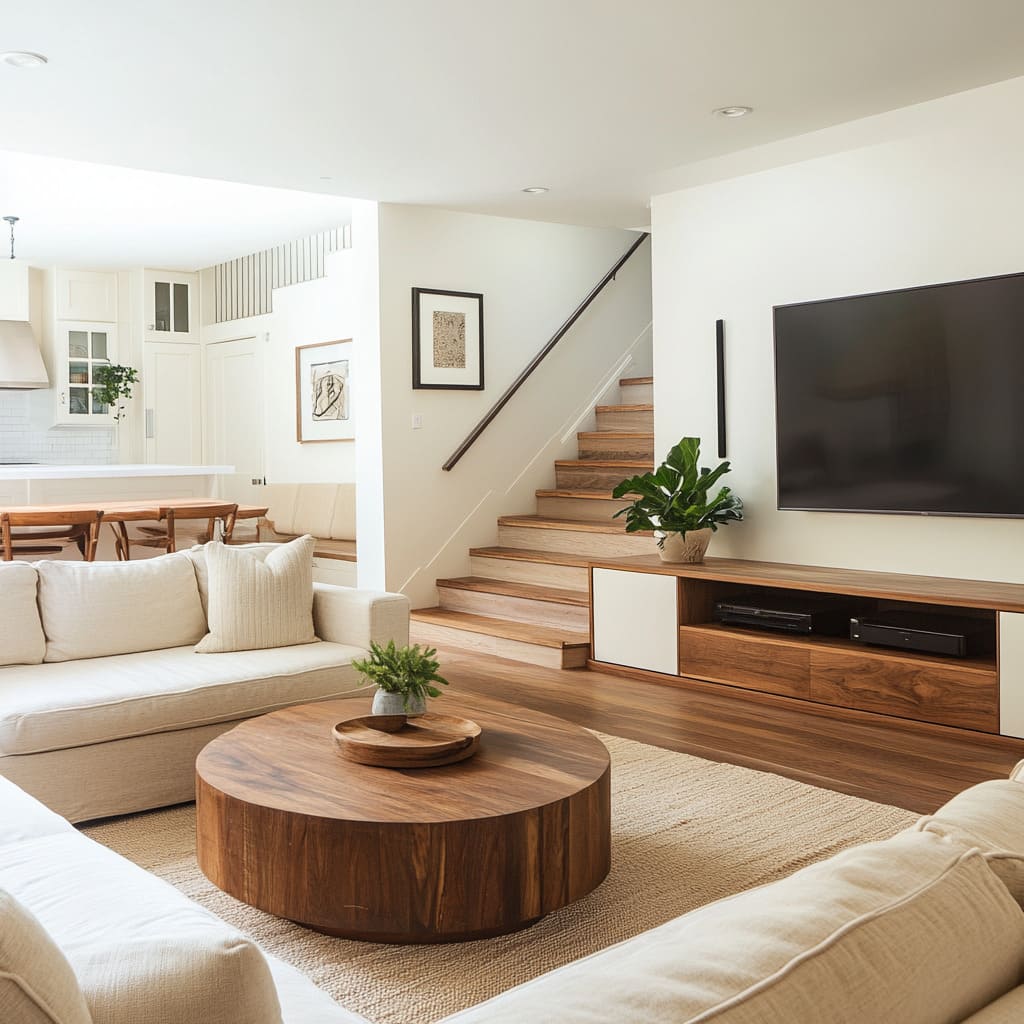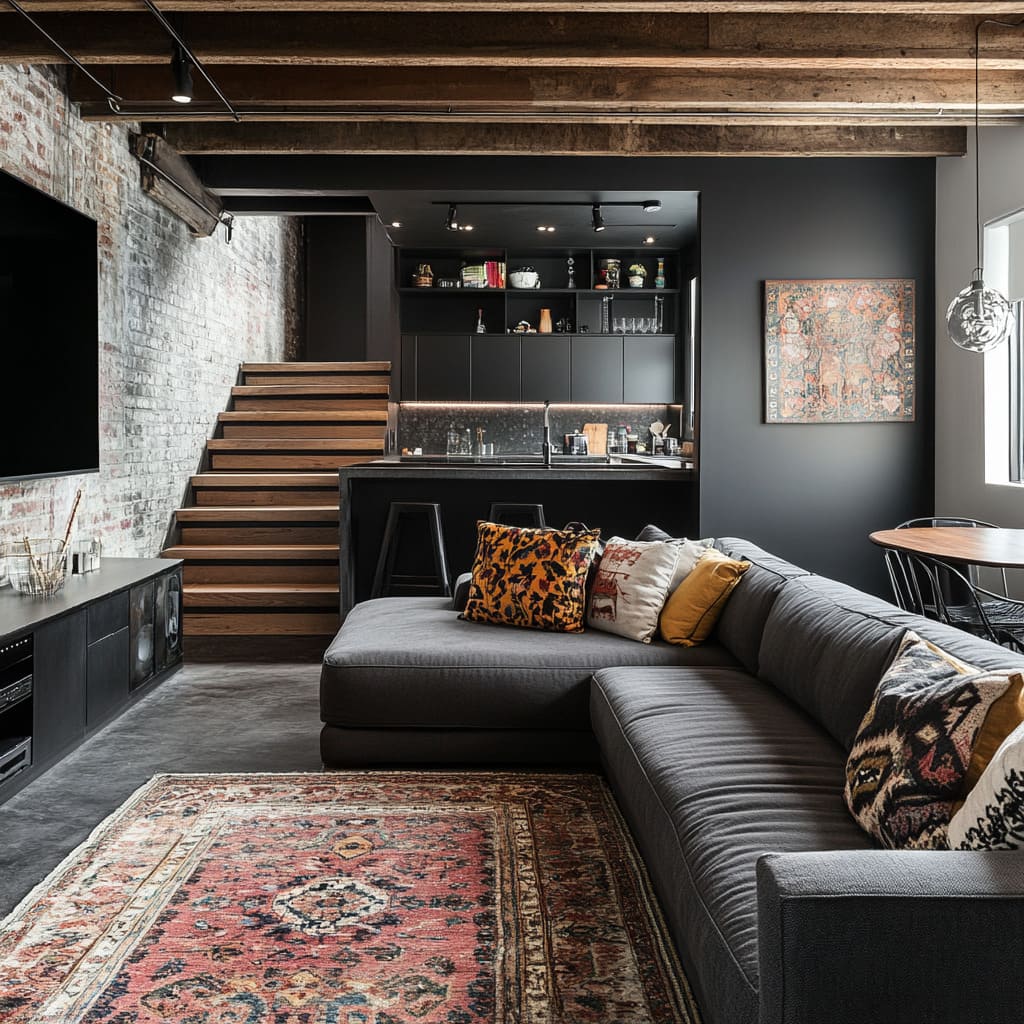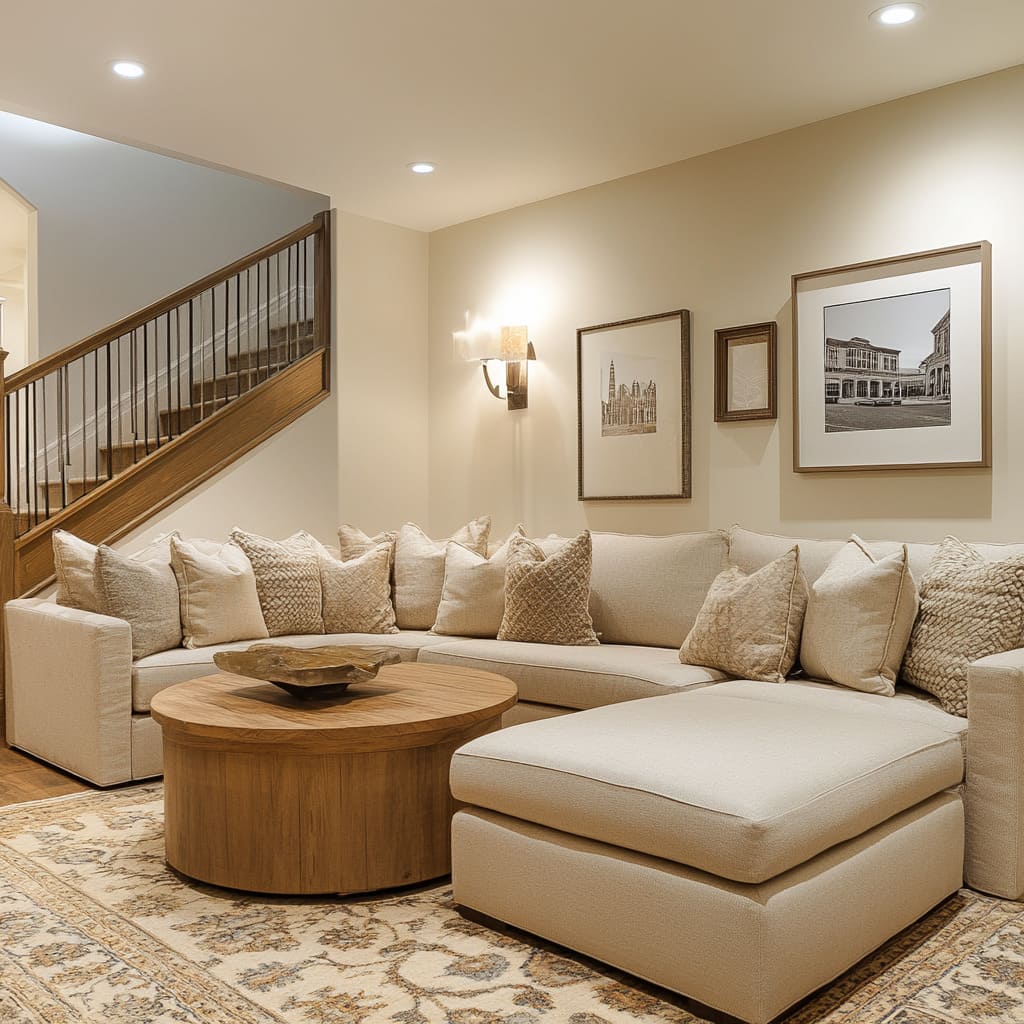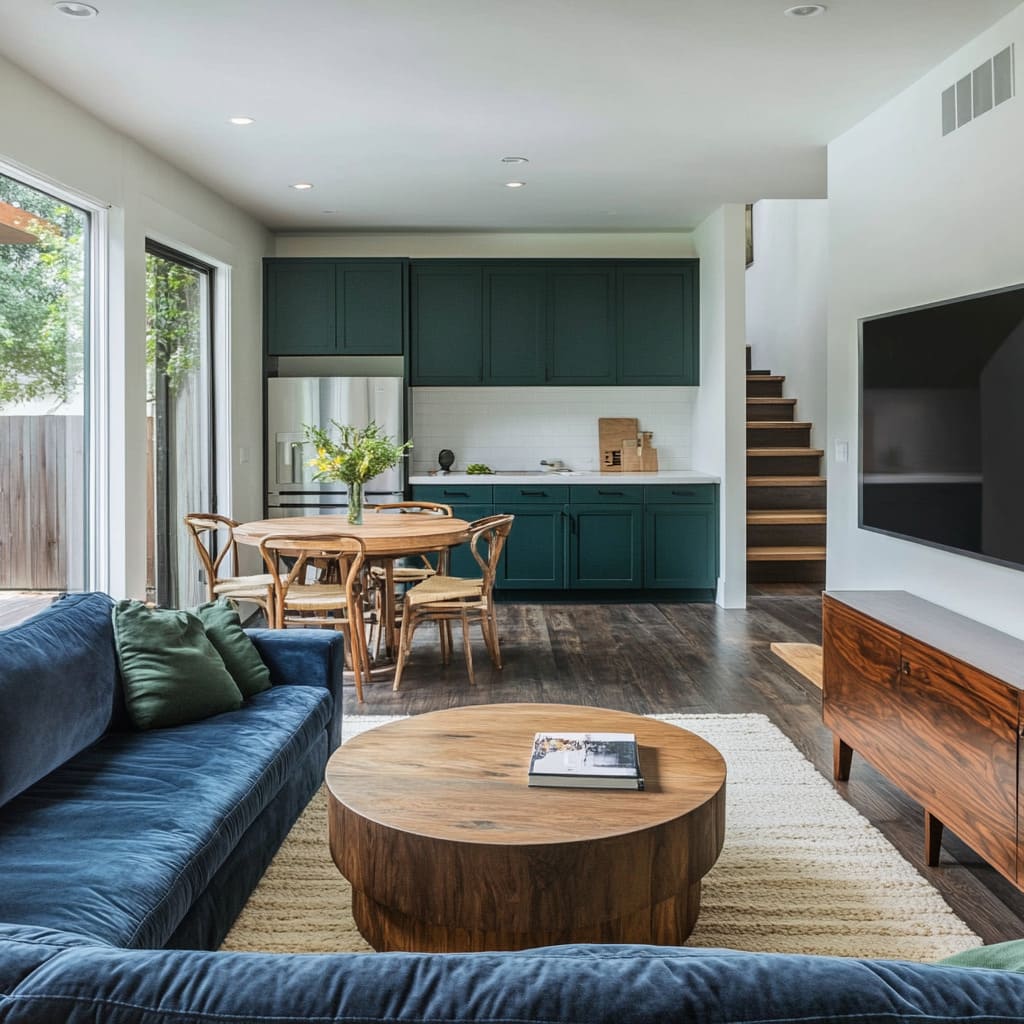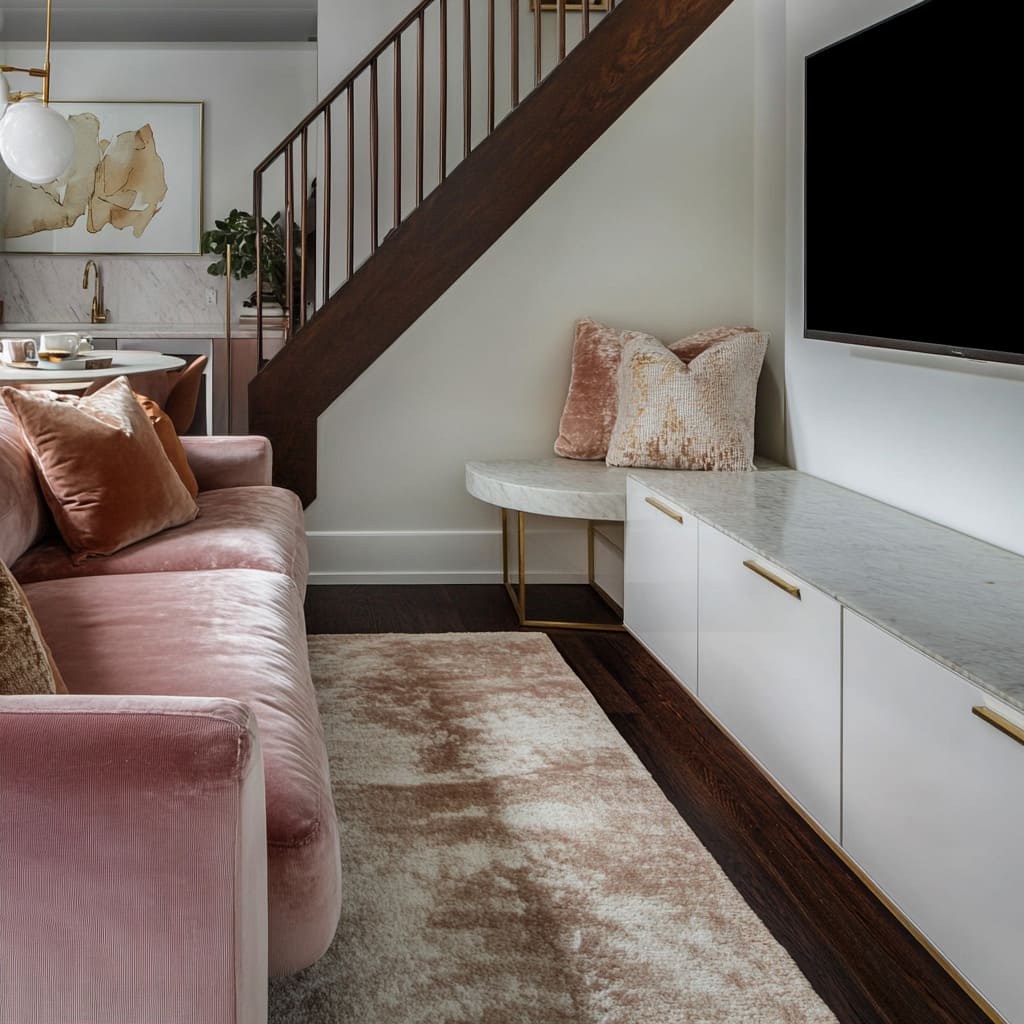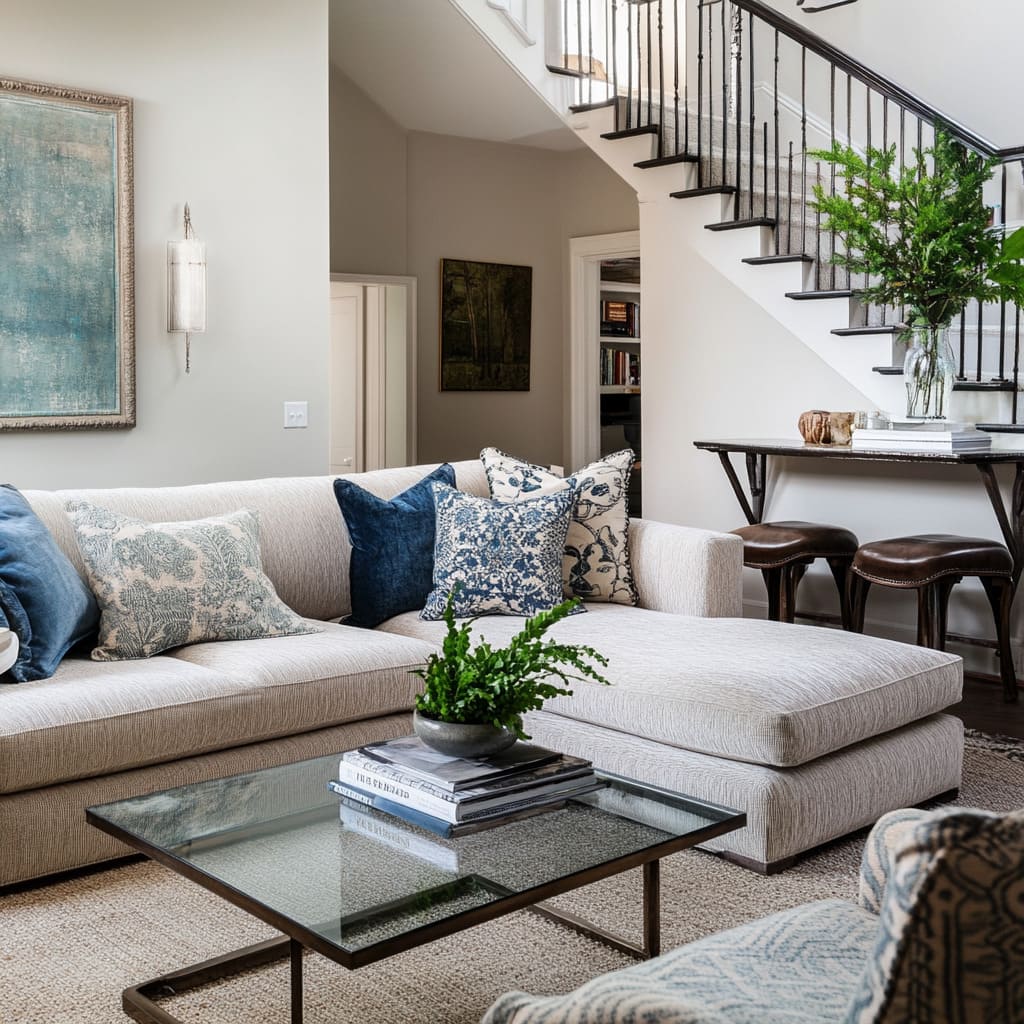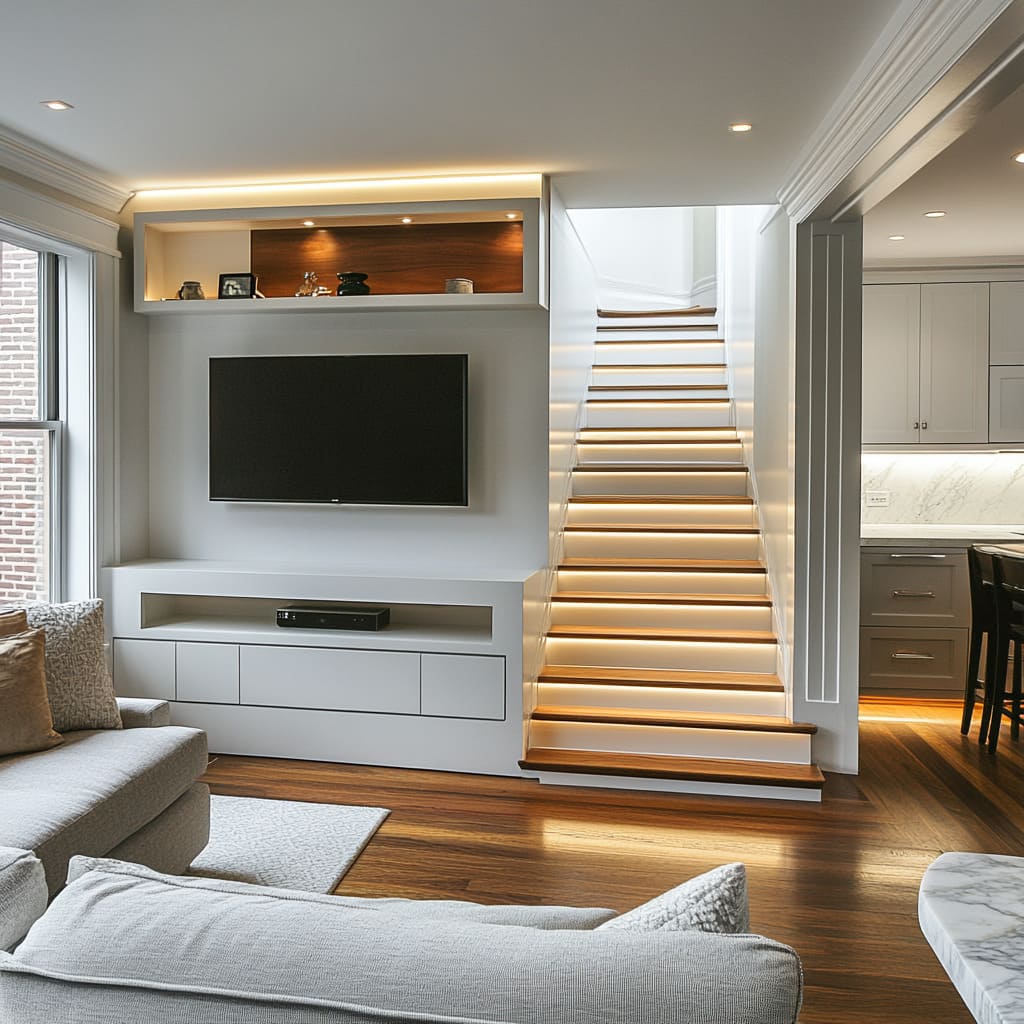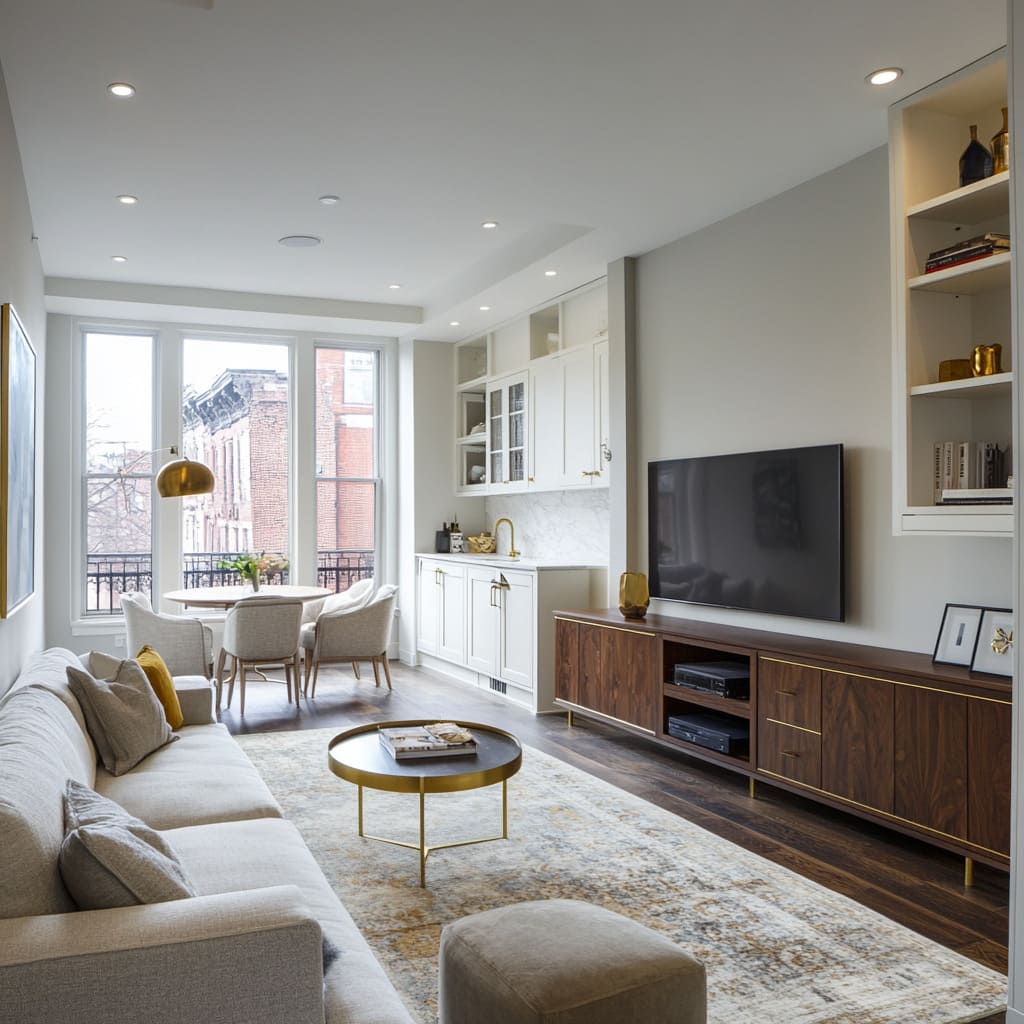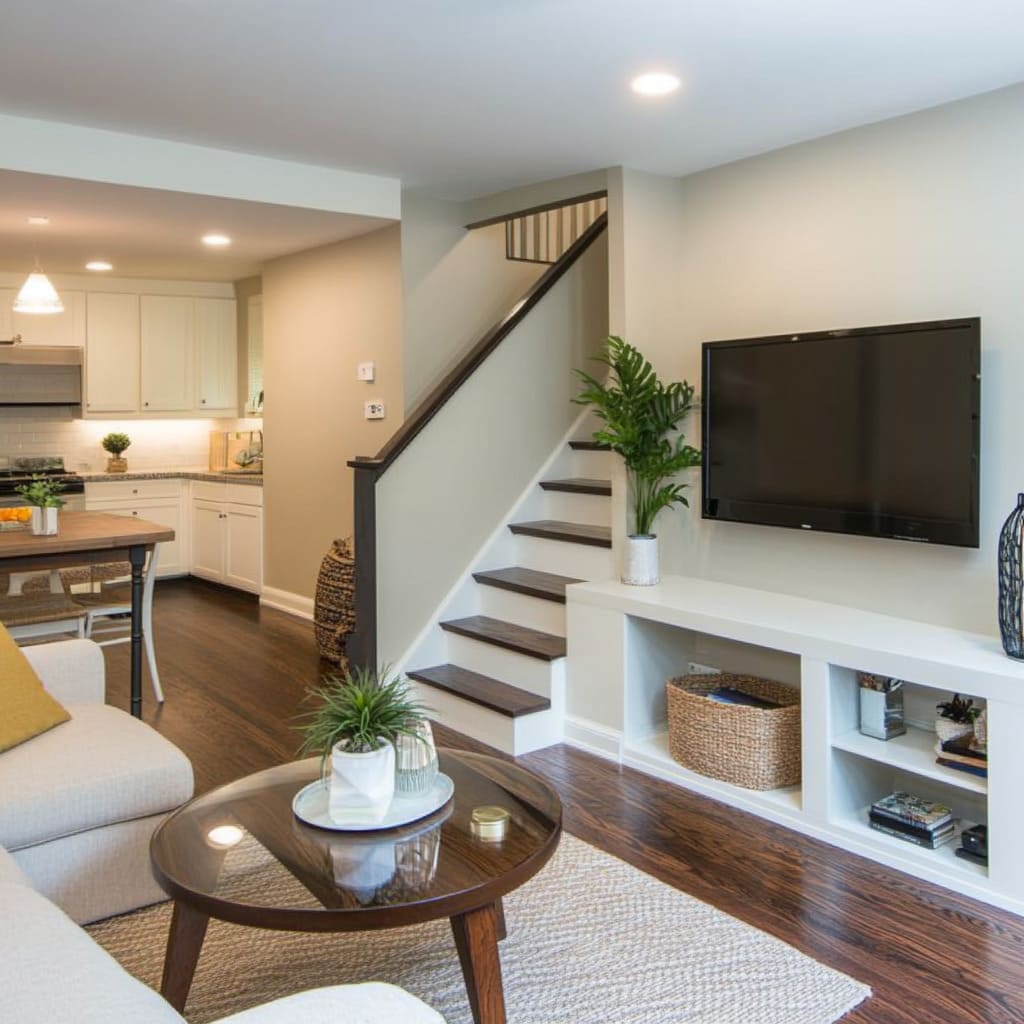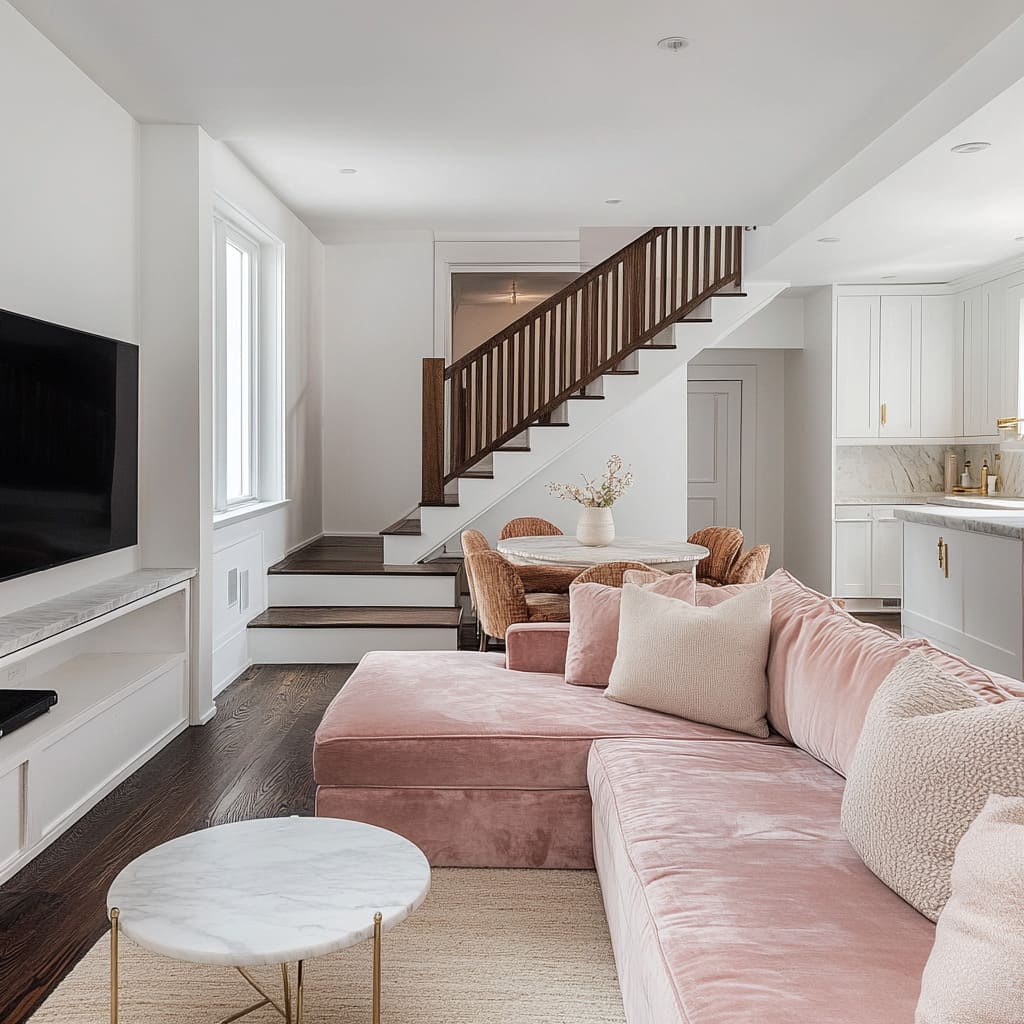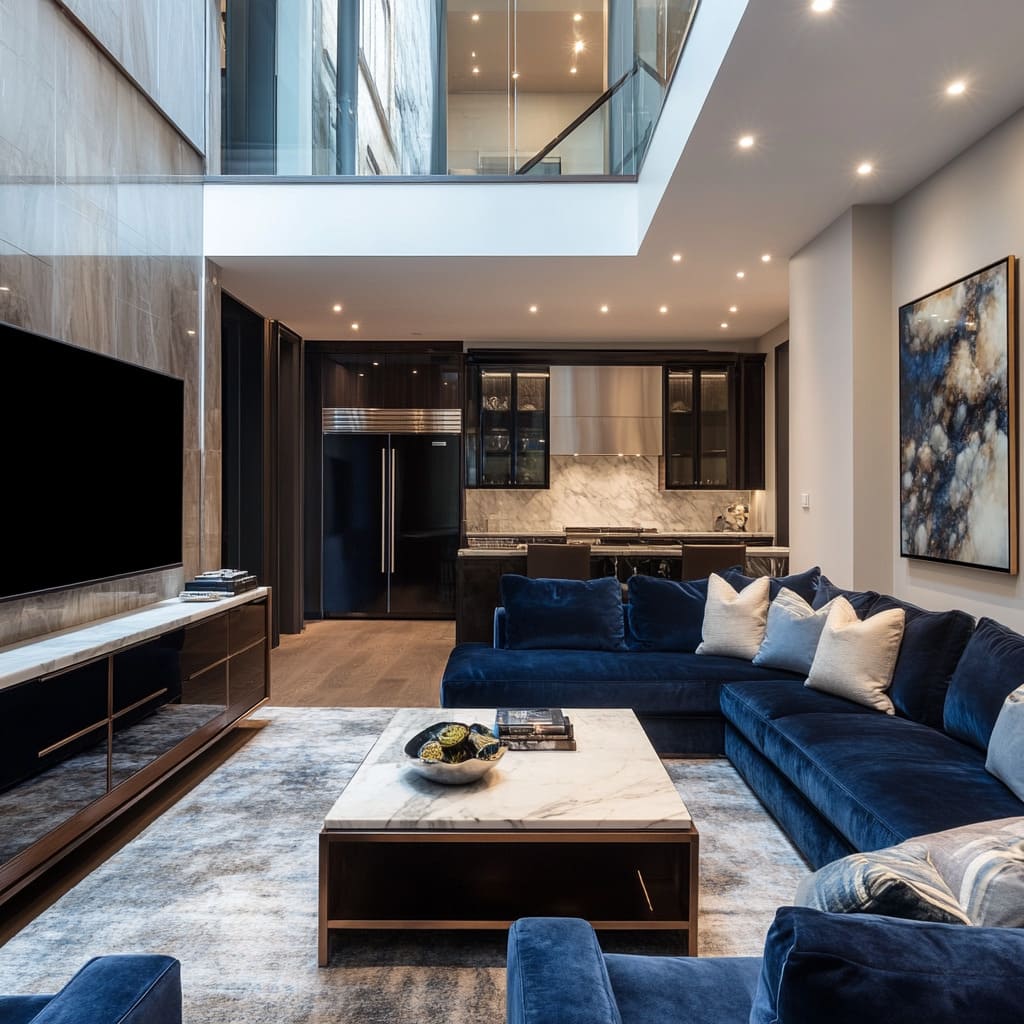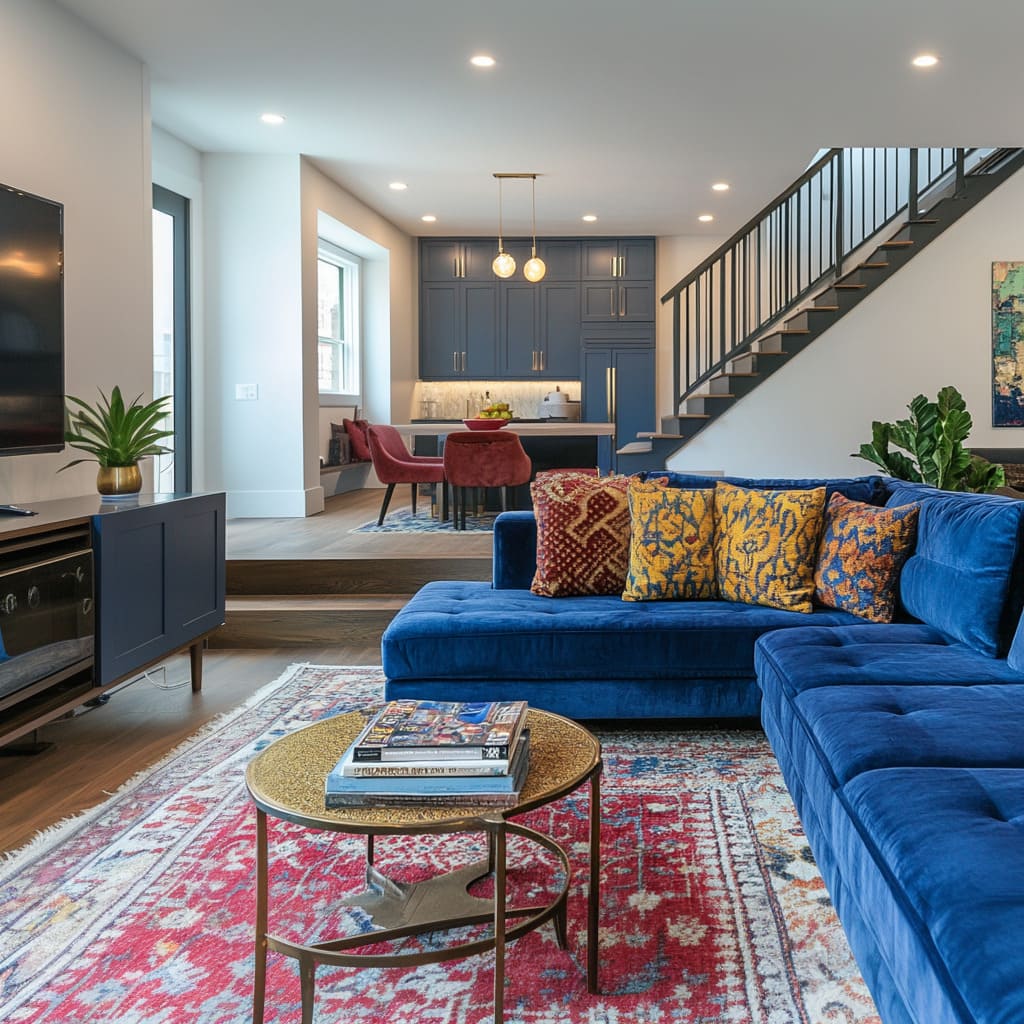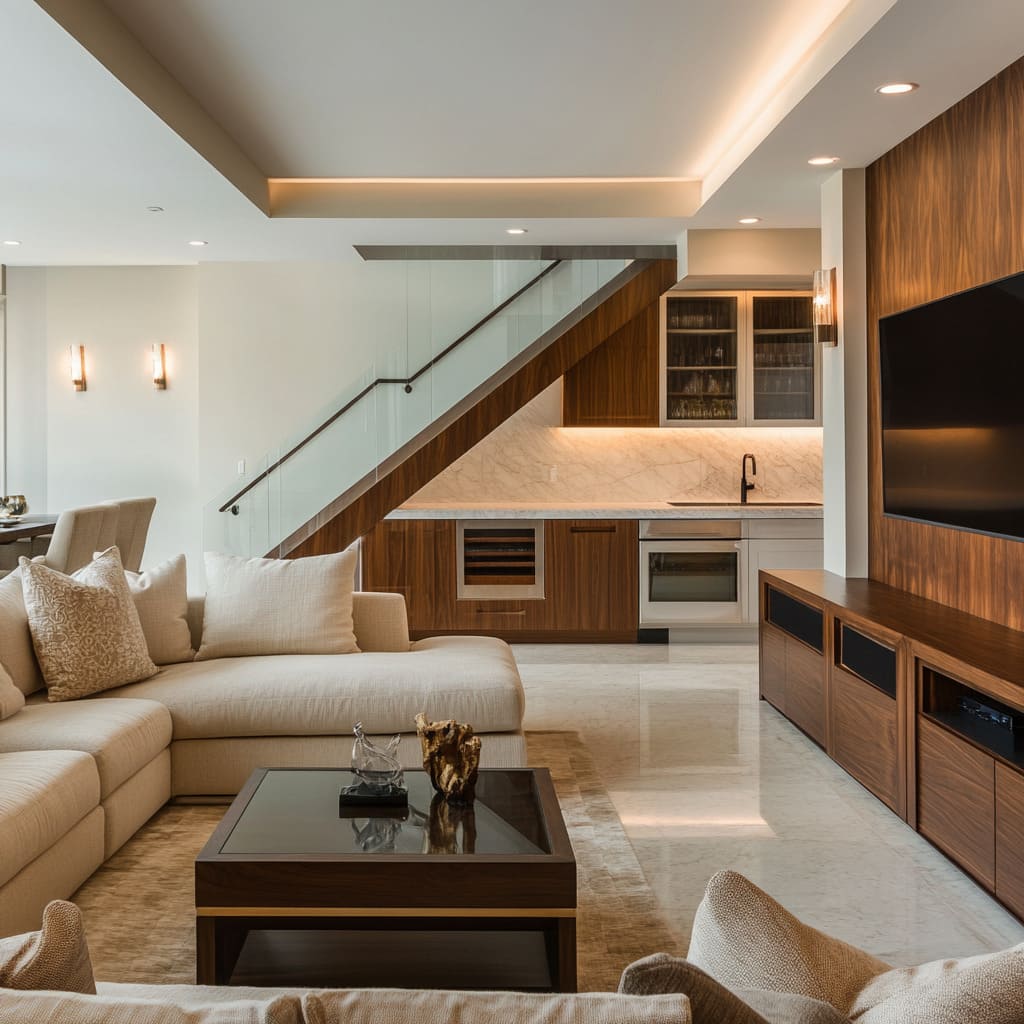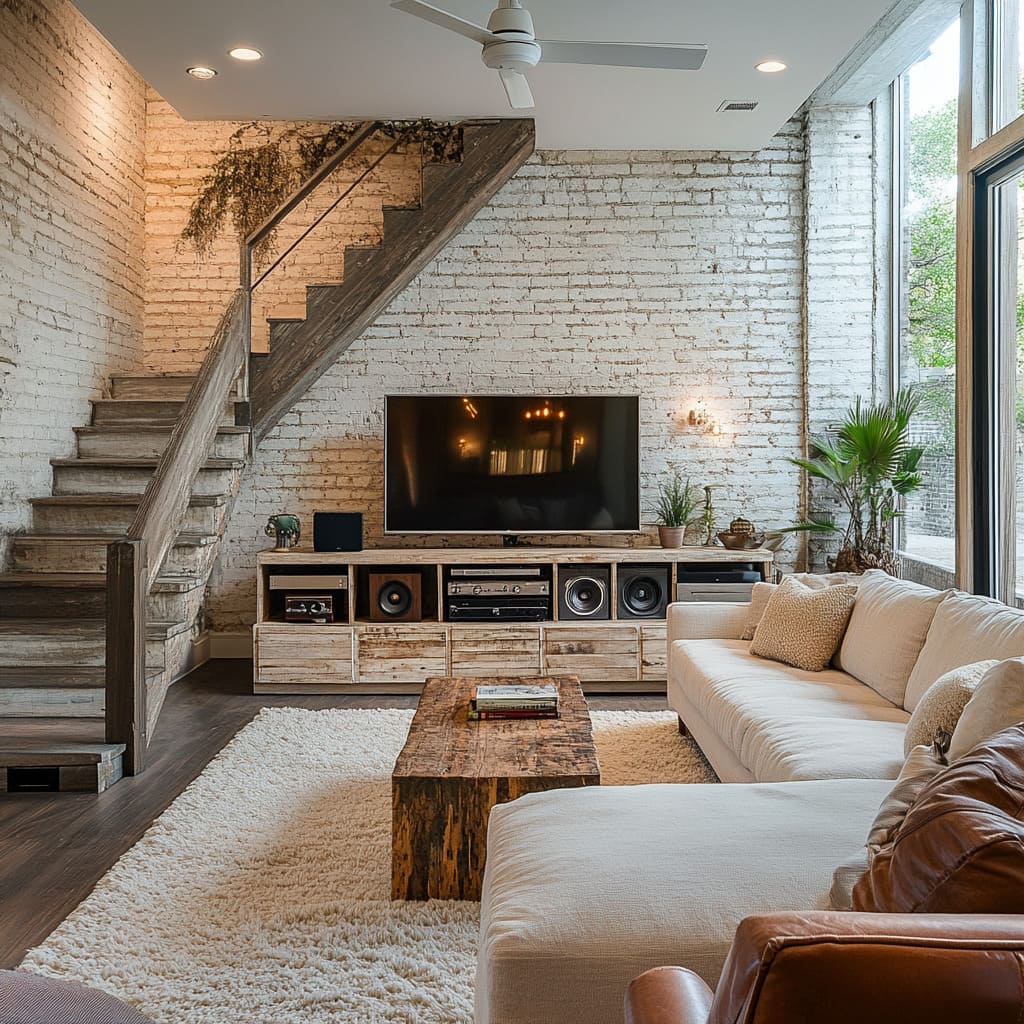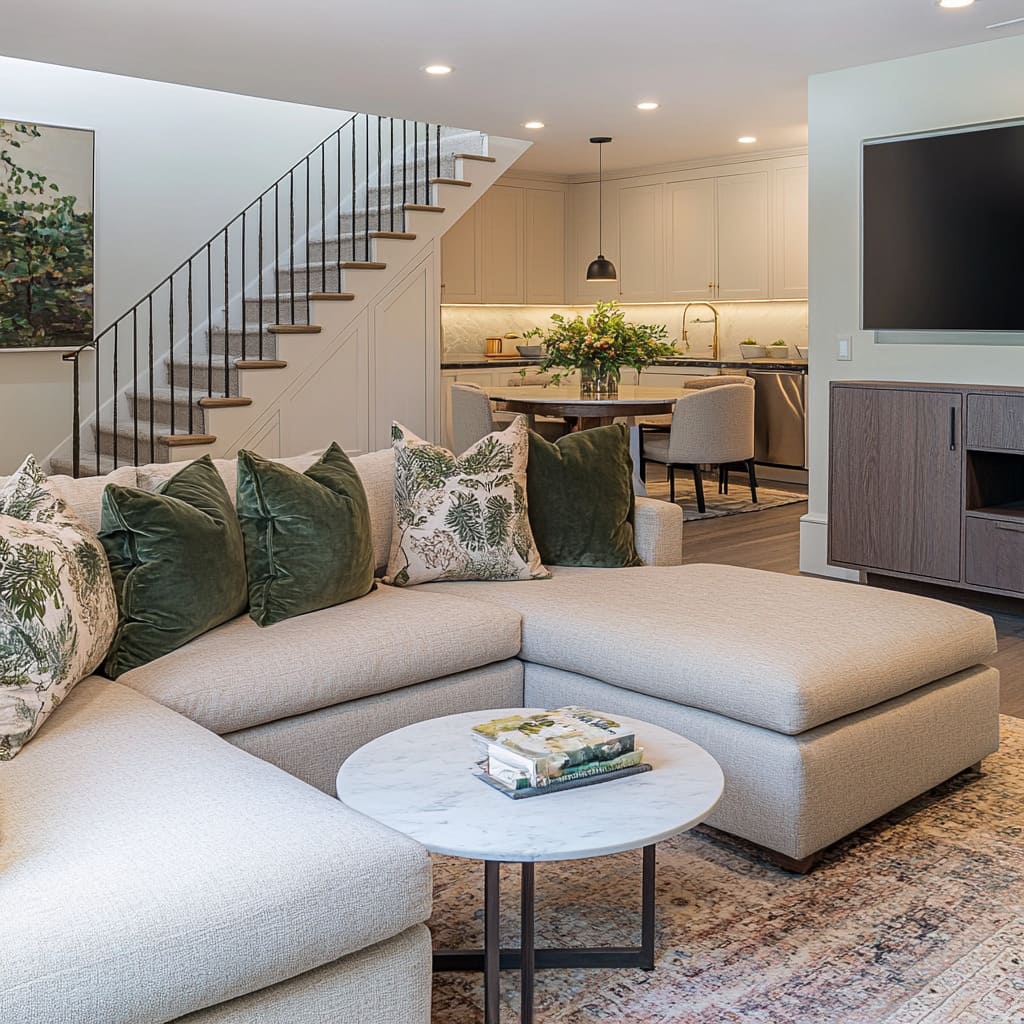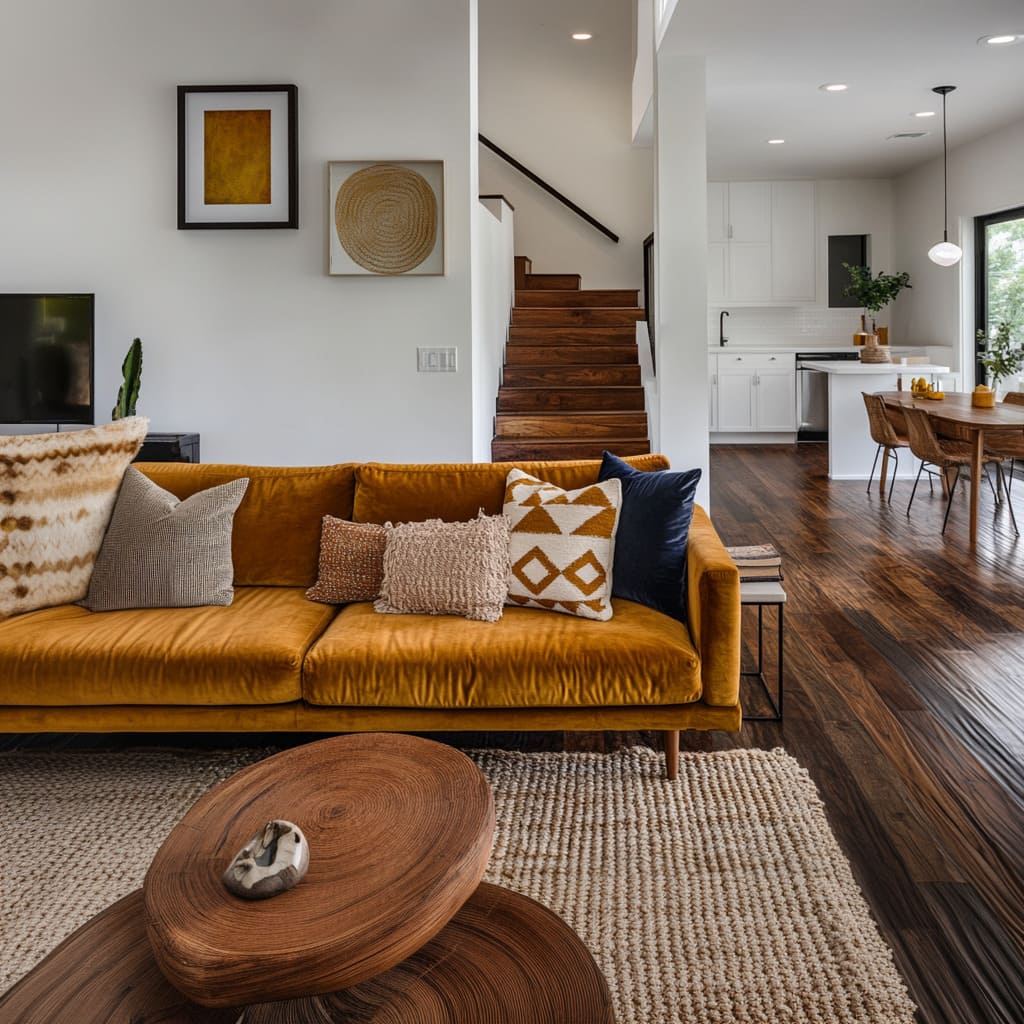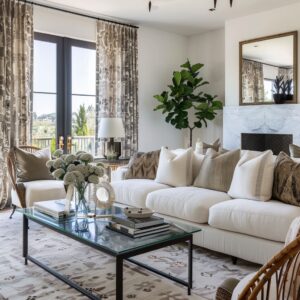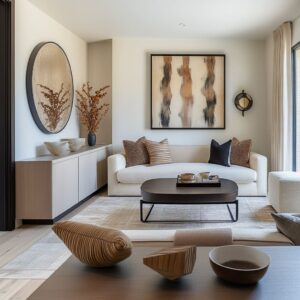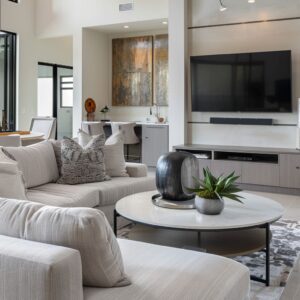Designing a small split-level living room comes with a unique set of challenges and opportunities. These spaces, often found in urban homes or compact residences, feature multiple levels within one open space.
The appeal lies in their ability to create visual interest and distinct zones, all while keeping the overall floor plan fluid and connected. However, the challenge lies in maximizing the potential of these compact areas, ensuring that every corner is both functional and visually appealing without feeling cramped.
The role of color and furniture is crucial in shaping these spaces. When carefully selected, they can significantly enhance the sense of openness and flow, making the living area feel larger than it actually is.
The right hues can amplify natural light, and the strategic use of furnishings can define each zone, allowing the space to serve multiple purposes seamlessly. The secret is in finding the right balance between creating cozy nooks and maintaining an open, cohesive feel.
Thoughtful design choices, whether through color palette or smart furniture arrangement in a split-level living room, can make a space not only functional but also stylish and welcoming. By playing with textures, materials, and a mix of modern and cozy elements, homeowners can transform these compact areas into well-organized, vibrant spaces that feel far more spacious and inviting than their square footage suggests.
Understanding the Split-Level Layout
A split-level living room, sometimes called a bi-level layout, is an architectural style where the floor plan is divided into two or more levels, often connected by short staircases. Unlike traditional open layouts, which typically have one continuous floor, split-levels utilize vertical separation to create distinct yet connected zones within the same space.
This approach allows for the optimization of square footage, making small homes or compact apartments feel more spacious and dynamic.
The split-level style often includes features like a sunken living room area, which is set lower than the adjoining kitchen or dining space. This subtle elevation change not only adds depth and dimension but also helps in defining each section without the need for full walls or heavy partitions.
It’s a design solution that enhances the flow and visual interest of a small space, transforming it into a multi-functional area that feels both open and intimate.
Benefits of a Split-Level Layout:
One of the biggest advantages of the split-level living room design is its ability to create distinct zones within a compact footprint. In small homes, this layout offers a clever way to separate spaces for different activities—like lounging, dining, or working—without the need for enclosed rooms.
For instance, the lower section might serve as the main lounging area with a sofa and media unit, while the elevated section could house a dining table or home office desk. This kind of layout maximizes the use of each section, making the room versatile and efficient.
The split-level design also lends itself well to a variety of decorating and furniture arrangement ideas for split-level living rooms. By strategically placing furniture pieces in each section, homeowners can create a sense of purpose and separation without breaking the visual continuity.
For example, placing an L-shaped sofa along the edge of the lower level can subtly delineate the lounging area while still allowing for an open view of the elevated dining or kitchen space. Similarly, using compact furniture pieces in each zone ensures that the space remains functional yet airy.
Additionally, this layout is highly adaptable to different aesthetic preferences. Whether one prefers a modern, minimalist look with clean lines and neutral tones or a cozy, rustic style with warm wood finishes, the split-level structure provides a canvas for various decorating approaches.
Homeowners looking for split-level living room ideas can play with textures, such as exposed brick or wood panels, in one section while keeping the other area more refined with polished concrete or smooth walls. This variation in textures and finishes helps in defining the space while maintaining a cohesive feel.
The flexibility of a split-level layout also allows for easy integration of functional elements, like built-in shelving or floating desks, into the design. These additions can make the most of otherwise underutilized areas, transforming them into practical yet stylish features.
For instance, the wall along the staircase might be perfect for installing a sleek bookcase or a work-from-home nook that blends seamlessly into the room’s overall style.
In essence, the split-level layout not only offers architectural interest but also opens up a range of possibilities for furniture placement and design, making small spaces feel much larger and more purposeful. It’s an approach that caters well to modern living, where maximizing every square foot without compromising style is key.
Maximizing Light to Expand Space
Maximizing light is one of the most effective strategies for enhancing the sense of space in small split-level living rooms. The clever use of both natural and artificial lighting can make a room feel open and airy, creating an environment that feels larger than its actual dimensions.
This section covers essential techniques for integrating natural light effectively and selecting artificial lighting that enhances depth and warmth.
Natural Light Integration
Large windows are a game-changer when it comes to opening up small spaces. In split-level living rooms, they serve not only as a source of light but also as a visual link to the outside world, blurring the boundaries between the indoors and outdoors.
By bringing the outdoors in, they create the illusion of a more expansive living area. When planning a split level living room design, incorporating floor-to-ceiling windows or wide glass doors can be incredibly impactful.
Such features flood the space with light and offer a sense of continuity, which is crucial in compact environments.
Positioning furniture to make the most of this light is also key. For example, placing a sofa directly opposite a window not only maximizes the view but ensures that the seating area feels bright and open.
Avoid blocking the natural light source with bulky furniture; instead, opt for low-profile sofas and armchairs that allow light to flow through. Using sheer or lightweight curtains rather than heavy drapes helps maintain privacy without sacrificing the light that fills the room.
In split-level layouts, it’s especially important to ensure that both levels benefit from this natural light by keeping window treatments minimal and using mirrors to reflect light throughout the space.
Artificial Lighting Choices
While natural light sets the foundation, artificial lighting fills in the gaps, ensuring the room feels bright and inviting, day or night. In a living room layout for split level home spaces, layering different types of lighting can create depth and enhance architectural details without overwhelming the space.
When used together, these lighting methods work to create an atmosphere that’s layered and dynamic, perfect for highlighting the unique aspects of living room ideas for split level homes.
The Power of Color in Small Spaces
Color plays a significant role in shaping how we perceive a room’s size and depth. For small split-level living rooms, the right palette can amplify natural light and create a sense of continuity that expands the space visually.
Whether through the use of neutral tones or strategic pops of color, a well-chosen scheme can transform a compact room into a comfortable and cohesive living area.
Using Neutral Backdrops
Neutral backdrops are a tried-and-true method for making small spaces feel open and inviting. Colors like light gray, soft white, and warm beige work exceptionally well in split-level layouts, as they reflect natural light and make the room appear larger.
Unlike stark whites, which can sometimes feel cold, these softer neutrals add warmth while maintaining a bright and airy atmosphere. When planning a split-level living room design, using these hues as the base for the walls creates a canvas that can be built upon with other design elements.
To avoid a monotonous look, incorporating subtle variations of these shades can add depth without overwhelming the room. For instance, pairing a light gray wall with a slightly darker shade for trim or built-in shelving introduces visual interest while maintaining the cohesive feel essential in small spaces.
Accent Colors for Vibrancy
While neutrals expand the space, accent colors inject life and personality into the room. Vibrant shades like mustard yellow, teal, or earthy green work well as accents, especially in split-level homes where defining zones is key.
These colors, when used sparingly through throw pillows, small decor pieces, or wall art, create focal points that draw the eye, making the space feel dynamic without overpowering the overall aesthetic. Incorporating these colors in a split-level setting can help visually distinguish between the levels without the need for physical barriers.
For instance, using a teal throw blanket on a lower-level sofa and coordinating it with a similar-colored art piece or cushion on the upper level ties the spaces together, reinforcing the flow between the two areas.
Continuity with Wood Tones
In split-level rooms, wood tones can be a unifying element that enhances both warmth and continuity. Using consistent wood tones—such as light oak or natural pine—for flooring, stairs, and built-in furniture pieces ensures the space feels connected.
When each level features the same wood finish, it not only blends the two spaces but also visually lengthens the room, making it feel more expansive. Additionally, matching wood tones with other elements, like floating shelves or coffee tables, creates a cohesive look that enhances the overall flow.
For instance, if the staircase is finished in light oak, choosing a matching media console or side table helps to visually integrate the levels. This approach works particularly well in split-level homes, where maintaining a sense of unity across different sections is essential for a cohesive and spacious feel.
In summary, combining the right neutral backdrops with thoughtful accent colors and consistent wood tones creates a split-level living room that feels open, welcoming, and well-organized. By carefully selecting these elements, homeowners can transform even the smallest of split-level spaces into stylish, functional, and visually appealing areas.
Furniture Choices for Small Split-Level Spaces
When decorating a small split-level living room, choosing the right furniture can transform the space from cramped and disjointed into a well-organized and inviting environment. Every piece should be selected to maximize functionality and style while maintaining an open, airy feel.
Below are specific strategies for optimizing sofa placement, choosing practical tables, and integrating accent chairs to make the most of every square inch in a split-level living room layout.
Optimizing Sofa Placement
The sofa is the centerpiece of any living room, and in a split-level setting, it plays an even more crucial role in defining the space. In smaller areas, compact sectionals or modern sofas with clean lines work best to avoid overwhelming the room.
Neutral-toned options—such as grays, beiges, or soft whites—are ideal because they blend seamlessly with the room’s palette, amplifying the natural light and enhancing the sense of space. When placing the sofa, consider the flow between levels.
An L-shaped or low-profile design can be positioned strategically to create a boundary between the lower living area and the upper section, like a dining nook or workspace. This layout not only maximizes seating but also maintains a clear line of sight, which is vital in keeping the room from feeling boxed in.
Placing the sofa against the staircase or parallel to large windows helps anchor the living area while preserving the openness of the split-level configuration. In split-level house living rooms, it’s essential to use furniture that complements the flow between levels.
Keeping the sofa’s height low allows the eye to move smoothly from one level to the next, ensuring that the space feels integrated rather than fragmented. Additionally, incorporating modular or sectional sofas offers flexibility, allowing homeowners to adapt the arrangement based on their needs, whether for lounging, entertaining, or creating a cozy reading nook.
Functional and Stylish Tables
Tables in a split-level living room must be both functional and lightweight to maintain a sense of openness. The coffee table is a central piece, and choosing the right style can significantly impact how the space feels.
Round or rectangular wooden tables are excellent choices, as they introduce a natural element that warms up the room without adding bulk. A wood tone that matches other elements, like the staircase or shelving, ensures visual cohesion, making the room feel unified and spacious.
For those looking to keep the area light and airy, glass-top coffee tables are a great option. They offer the surface needed for practicality but allow light to pass through, avoiding any visual blockage that a solid table might create.
In a tri-level living room, where maintaining sightlines between levels is crucial, such choices enhance the sense of openness while adding a contemporary touch. Side tables should also be considered, especially compact ones that can double as functional decor.
Small, round side tables placed next to the sofa or near an accent chair provide extra surfaces for lamps or books without cluttering the room. Choosing designs with thin, metallic frames adds a modern flair and ensures they don’t dominate the space.
Accent Chairs as Versatile Elements
Accent chairs are not only practical additions for extra seating but also a way to introduce variety and style into the room. In small split-level setups, selecting the right size and shape is key to ensuring they fit without obstructing flow.
Compact, rounded chairs work particularly well, as their soft curves contrast with the clean lines of the sofa and staircase, adding visual interest without creating congestion. When choosing accent chairs, it’s effective to opt for materials or colors that contrast with the sofa to break up the space visually.
For example, a leather chair in a warm tan can complement a neutral fabric sofa, adding depth and texture. This approach enhances the overall aesthetic and ensures the room feels thoughtfully curated.
The key is to pick lightweight and moveable options so they can be repositioned as needed without affecting the overall layout.
Incorporating chairs that can be tucked into corners or angled slightly can also create intimate conversation areas without interrupting the space’s openness. If possible, place these chairs near architectural features, such as large windows or under a staircase, to utilize these often overlooked areas.
This not only maximizes seating but also takes advantage of every corner of the room.
Architectural Features and Their Impact on Space
In a small split-level living room, architectural features like the staircase play a prominent role in both function and aesthetics. Properly designed, they can enhance the space without becoming obtrusive or limiting.
Staircase Design Tips
Staircases are an integral part of any split-level design, but in small spaces, they need to be minimal and functional. A simple approach, such as metal railings with open balusters, helps keep the area feeling open.
This design choice minimizes visual obstruction, allowing light to pass through and ensuring the space feels cohesive and connected. Light wood steps are another effective option for ensuring the staircase doesn’t become too dominant.
Matching the wood tones of the steps with other elements, such as the coffee table or shelving units, ties the room together, creating a sense of harmony. By doing so, the staircase not only serves its practical function but also acts as a design feature that enhances the overall aesthetic.
Incorporating Built-In Units and Shelving
In small living rooms, maximizing vertical space is crucial. Built-in units, like media consoles or floating desks, are ideal for keeping the floor area open while providing necessary storage and functionality.
Media units that run along the wall under a mounted TV help anchor the space without making it feel cluttered. Opting for streamlined designs that match the wall color further integrates these pieces, avoiding any visual bulk.
Floating desks or wall-mounted shelves are also excellent solutions for utilizing wall space efficiently. These additions allow for work or display areas without taking up valuable floor space.
Open shelving, in particular, provides a place to display decorative items or plants while keeping everything light and accessible. When paired with subtle lighting, such as LED strips, these shelves not only serve a functional purpose but also become a feature that enhances the ambiance.
Vertical Space
In compact living areas, it’s essential to use vertical elements to draw the eye upward, giving the impression of more height and space. Incorporating wall-mounted decor, such as abstract art pieces or framed photos, helps to fill the walls without encroaching on floor space.
Placing these items above eye level encourages the eye to explore the entire height of the room, making it feel larger. Another tip is to add tall plants or sculptures that make use of the vertical dimension.
These elements contribute to the aesthetic without crowding the floor space, helping the room feel lush and thoughtfully decorated. In conclusion, every piece of furniture and architectural feature in a small split-level living room should be chosen and positioned with purpose, ensuring the space remains functional, visually cohesive, and open.
By integrating these strategies, homeowners can maximize their split-level spaces, making them stylish and practical retreats within the home.
Texture and Material Choices for Depth and Warmth
The use of texture and material is key in transforming a small, split-level living room into a cozy, layered, and visually interesting space. In compact layouts, it’s important to create depth without overwhelming the area, and the right combination of soft and hard materials can make a world of difference.
By carefully balancing textures and materials, one can achieve a room that feels warm and welcoming, yet structured and organized.
Mixing Textures to Add Dimension
Incorporating a variety of textures is a fundamental way to add dimension in a modern split-level living room. Exposed materials like brick or stone create an earthy, grounded feel, while wood grains on floors, stairs, or built-in units offer warmth and character.
These harder elements form the foundation, providing the room with structure. When combined with softer materials such as plush upholstery, cushions, or drapery, they create a balanced contrast that is visually appealing and comfortable.
For example, if the room has an exposed stone or brick wall, pairing it with a soft velvet sofa and woolen cushions not only enhances comfort but also introduces a tactile variety that invites touch and relaxation. Using smooth, polished wood for shelving or the coffee table contrasts beautifully with these soft furnishings, offering a mix of textures that creates visual depth without crowding the room.
The key is ensuring that the harder and softer materials work together, creating a cohesive, cozy environment that doesn’t feel too rigid or too cluttered. An effective way to manage this balance is by incorporating both vertical and horizontal textures.
Using vertical surfaces like wooden wall panels or metal railings for the staircase adds an interesting visual dynamic, while horizontal soft textures—such as rugs, plush throws, or upholstered chairs—anchor the space and provide a sense of comfort. The interplay between these materials enhances the overall look and feel of the split-level home living room, making it feel thoughtfully designed and well-balanced.
Rug Selection to Define Zones
Rugs play a significant role in small split-level layouts as they help define and anchor different zones within the space. Given the multi-level nature of these homes, using area rugs with subtle patterns can demarcate the seating area while adding warmth and texture.
Rugs also have the advantage of introducing another layer of design without taking up physical space. When choosing a rug, it’s important to select one that matches the overall color scheme of the room.
Subtle patterns, such as geometric designs in muted tones or monochromatic motifs, complement the room’s palette without drawing too much attention. These rugs tie the seating area to other elements, such as throw pillows or wall art, creating a sense of cohesion that is crucial in maintaining a unified design across split levels.
The size of the rug is another important consideration. It should be large enough to fit under all major furniture pieces, like the sofa and coffee table, to visually unite them as one zone.
This approach prevents the area from looking fragmented and instead makes it feel like an intentional, cozy space. Opting for natural materials like wool or cotton in neutral tones helps enhance the overall warmth while keeping the focus on the textures rather than bold colors.
Decorative Accents and Personal Touches
Decorative accents are the finishing touches that bring personality and charm to any living space. In a small split-level living room, they must be chosen with care to avoid overcrowding the space.
A minimalist approach works best, ensuring that each piece adds character without making the room feel cluttered.
Choosing Minimalist Decor
Minimalist decor allows the eye to move freely across the room without being overwhelmed by visual noise. Simple artwork, such as abstract prints in soft hues, can bring color and interest without dominating the space.
Hanging these pieces on the staircase wall or above the sofa draws attention to specific areas and breaks up large, blank surfaces. It’s important to select art that ties into the color scheme, so everything feels connected rather than random.
Small potted plants are another great way to introduce life and color. Placed strategically on built-in shelves, side tables, or window sills, they add freshness without taking up too much space.
In a bi-level living room furniture placement, choosing slim, tall planters or hanging options can enhance the vertical dimension of the room, ensuring that the floor area remains open and accessible.
When styling shelves or coffee tables, less is more. A few carefully curated items, like a stack of books, a small vase, or a candle, can make a big impact without crowding the space.
The goal is to maintain a sense of openness while ensuring that each item contributes to the overall aesthetic.
Using Plants to Connect Indoor and Outdoor Spaces
Plants not only add a natural element to the room but also help bridge the gap between the indoor and outdoor areas, especially when positioned near windows. Large windows, often featured in split-level designs, are perfect for displaying greenery.
Placing tall plants near these windows extends the view, creating a connection with the outside and making the room feel more spacious. Opting for low-maintenance plants like succulents or snake plants is practical and stylish.
These plants fit seamlessly into various decor styles, whether modern or rustic, and they thrive with minimal care. Hanging planters or wall-mounted green displays can also be used to introduce greenery without sacrificing floor space, which is particularly important in compact areas.
Incorporating these elements ensures that the room feels fresh, inviting, and connected to the surrounding environment. Overall, a thoughtful blend of textures, minimalist decor, and strategic use of greenery can transform a split-level living room into a welcoming space that feels open and harmonious.
By integrating these elements, homeowners can create a room that not only serves its function but also provides a sense of warmth and personality that enhances the overall living experience.
Unifying the Room with Flooring
Flooring is a foundational element in any living space, but its significance is amplified in small split-level living rooms. It plays a key role in visually tying different levels together, creating a cohesive look that enhances the sense of openness.
Choosing the right flooring materials and accents ensures a seamless and connected flow, transforming what could be a fragmented area into a unified, functional space.
Consistent Flooring for Visual Flow
One of the most effective ways to achieve visual continuity in a small split-level living room is by using consistent flooring across all levels. Light wood, for instance, works particularly well in these settings.
Its natural, warm tone complements most color schemes and adds a sense of depth without overwhelming the room. By using the same flooring material throughout, you eliminate the visual disruption that could arise from using different finishes or colors on each level.
This approach extends the visual field, making the space feel more expansive. When selecting flooring materials, it’s crucial to ensure they harmonize with the overall palette of the room.
For a cohesive design, pick wood tones that blend with other wooden elements like furniture, shelves, or staircases. This alignment not only enhances the flow but also ties the entire aesthetic together.
If light wood doesn’t suit your style, other options such as polished concrete or tiles in soft, neutral shades can also create a seamless look. The goal is to choose a material that complements the room’s textures and colors, reinforcing unity rather than introducing visual breaks.
For those exploring small split-level living room ideas, a practical tip is to use flooring that reflects natural light, such as matte-finished wood or tiles with a subtle sheen. This not only brightens the space but also amplifies the perception of room size, making even the most compact living area feel open and inviting.
Using Area Rugs for Coziness and Zoning
While consistent flooring creates visual harmony, area rugs add comfort and help define different zones within the split-level layout. Rugs are a versatile tool in these spaces; they can be used to anchor the seating area, providing a cozy contrast to the sleekness of the hard flooring.
Selecting the right rug is essential—choose one that fits well within the dimensions of the living area, ensuring it doesn’t interrupt the flow between levels but rather enhances the feeling of continuity. To keep the space feeling unified, match the rug’s color palette with other elements in the room, such as cushions, throws, or wall art.
For instance, a rug with subtle geometric patterns or neutral tones can harmonize with both the sofa and accent chairs, creating a balanced and cohesive look. For split-level spaces, rectangular or square rugs work best, as they mirror the structural lines of the room and reinforce the sense of order.
Round rugs can also be effective in softening corners or creating a focal point in smaller nooks.
When applying living room ideas for split-level areas, area rugs can be strategically placed to highlight different sections—such as defining a seating area in the lower level while maintaining visual continuity with the upper section. By incorporating rugs that reflect the room’s textures and colors, you not only add warmth but also enhance the perception of a well-organized and intentional layout.
Final Touches and Styling Tips
Once the flooring and essential pieces are in place, it’s time to style the room with care. In small spaces, keeping the decor balanced and minimal is key to maintaining an uncluttered, airy feel.
Final touches should enhance the overall look while ensuring that the room remains functional and inviting.
Keeping the Space Uncluttered
Minimalism is essential in small split-level living rooms. It’s all about focusing on quality rather than quantity when it comes to decor and furniture.
By prioritizing a few carefully chosen items, you allow each piece to stand out without overwhelming the space. This approach not only preserves the open feel but also makes the room look more curated and sophisticated.
For instance, a single statement piece—like a sculptural lamp or a large abstract painting—can make a big impact without crowding the area. Organizing furniture and accessories effectively is vital, especially when working with bi-level living room decorating ideas.
Avoid overloading the space with decorative objects; instead, opt for functional yet stylish pieces that double as storage or can be moved easily. Small, versatile tables or ottomans, for example, can offer storage and seating without taking up too much space.
The idea is to keep the room visually open, enhancing the perception of spaciousness even in a compact area.
Layering Lighting for Ambiance
Lighting plays a huge role in shaping the atmosphere of a small split-level space. Layering different lighting sources—natural, pendant, and recessed—can create a warm, inviting environment.
Pendant lights are especially effective when placed strategically over key areas like the coffee table or dining nook. These lights draw attention to specific spots without crowding the space, and their placement can subtly highlight the room’s structure.
Recessed lighting, on the other hand, offers a clean and modern way to illuminate the room. It ensures an even distribution of light across both levels, making the space feel larger and more connected.
In compact living rooms, LED strips can also be added along shelving or under stair treads to enhance depth and give the room a contemporary edge. By varying the intensity and type of lighting in each zone, you can emphasize different aspects of the room and create a layered, cozy effect.
Personalizing the Space
Personal touches bring character and warmth to a split-level living room, making it feel like home. Adding small collections of books, artwork, or other meaningful objects allows homeowners to express their personality while maintaining a balanced design.
Curating these items carefully ensures the room remains open and visually light. For example, a small selection of books with a few art pieces on a built-in shelf adds interest without becoming cluttered.
When exploring furniture layout for a split-level living room, it’s crucial to balance these personal touches with practicality. Incorporate functional decor like stylish storage baskets or trays that organize items and keep surfaces clean.
This approach not only personalizes the space but also ensures that it remains tidy and functional. Plants can also be a great addition, especially in areas close to windows.
Low-maintenance greenery like succulents or ferns connects the indoors with the outdoor view, adding a fresh element without requiring much upkeep. Incorporating these final touches, combined with the strategic use of lighting and minimalism, allows a modern split-level living room to shine.
The result is a cohesive, inviting space that maximizes its architectural potential while reflecting the style and needs of those who live there.

